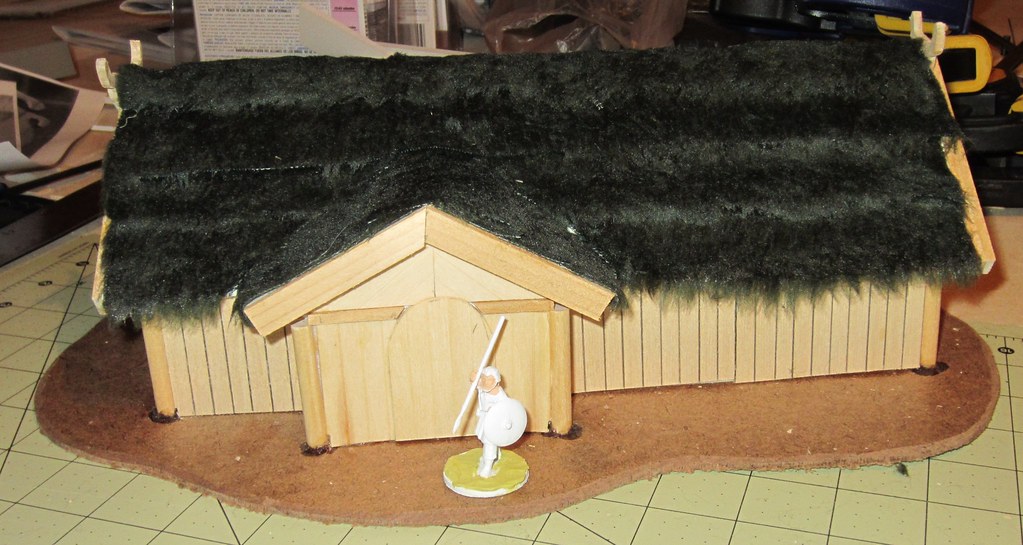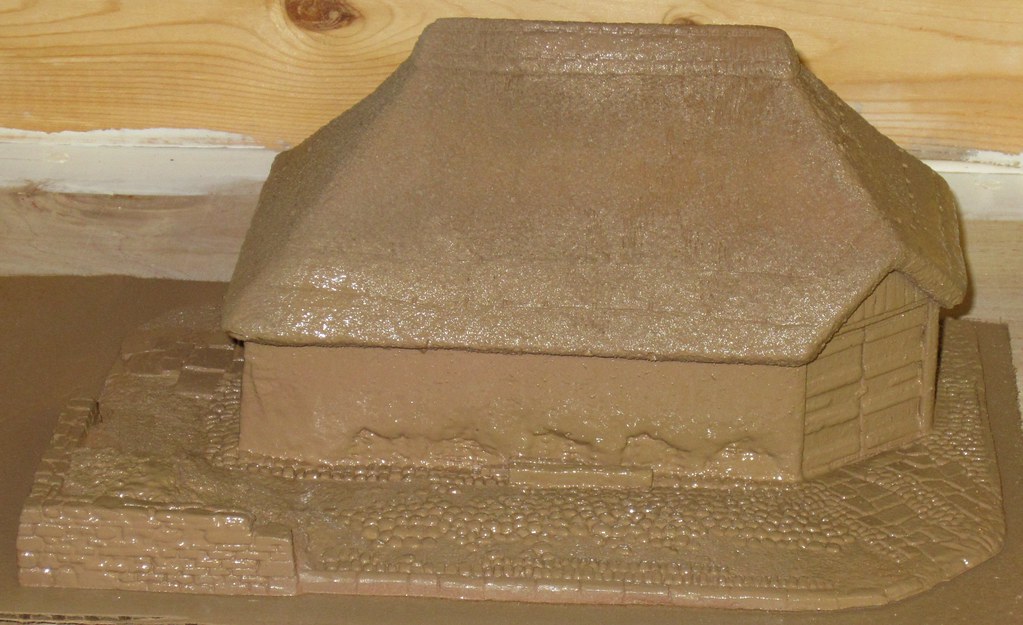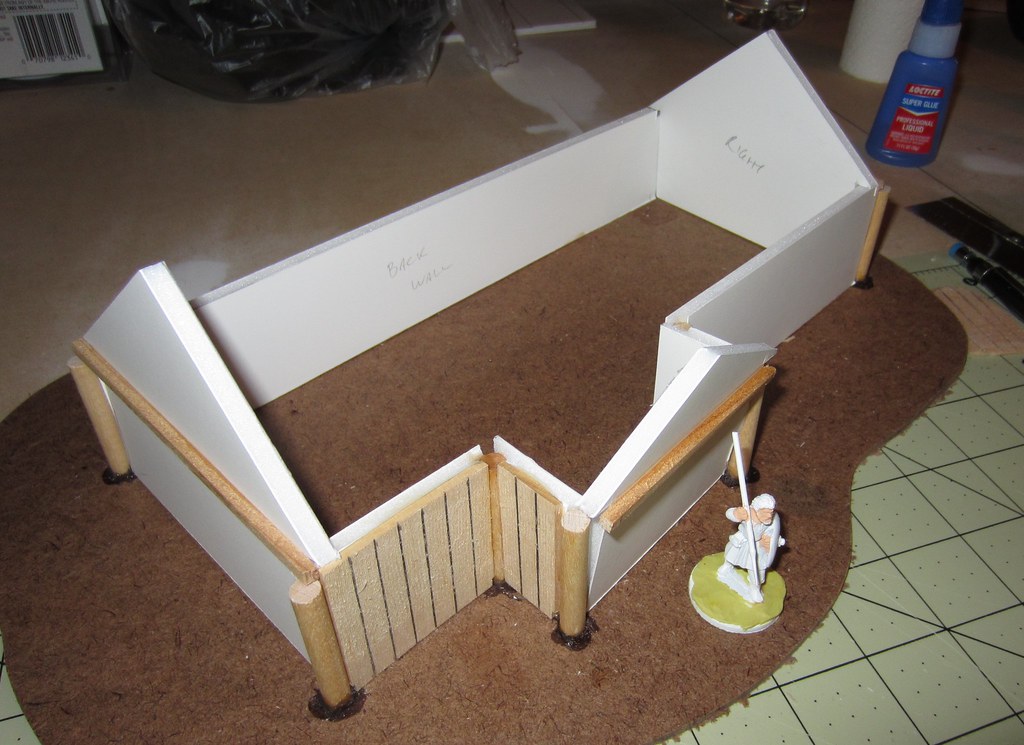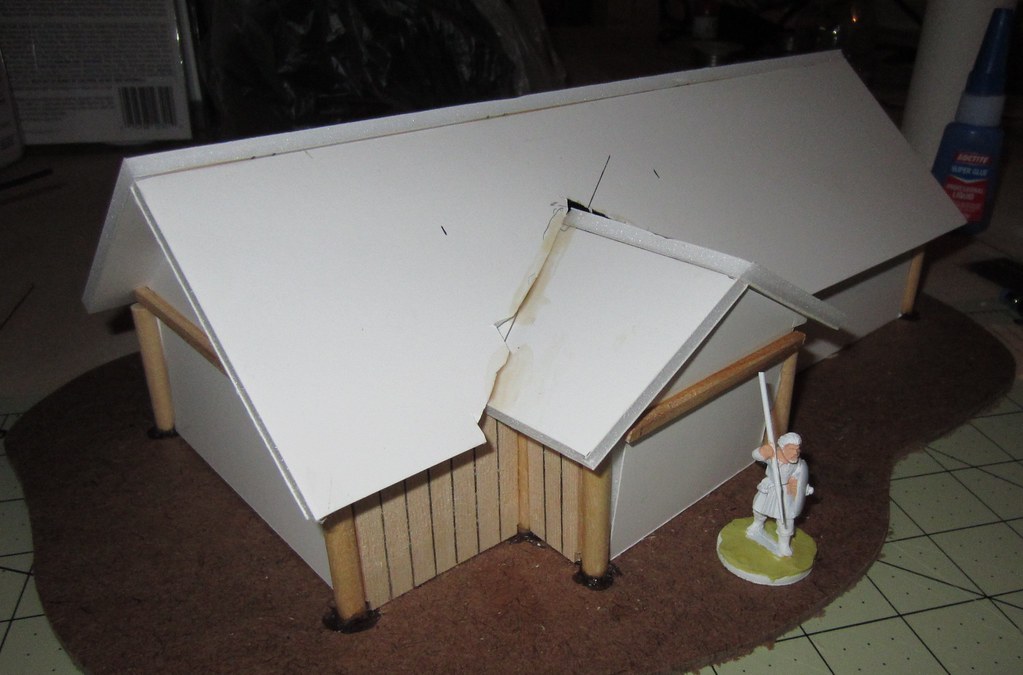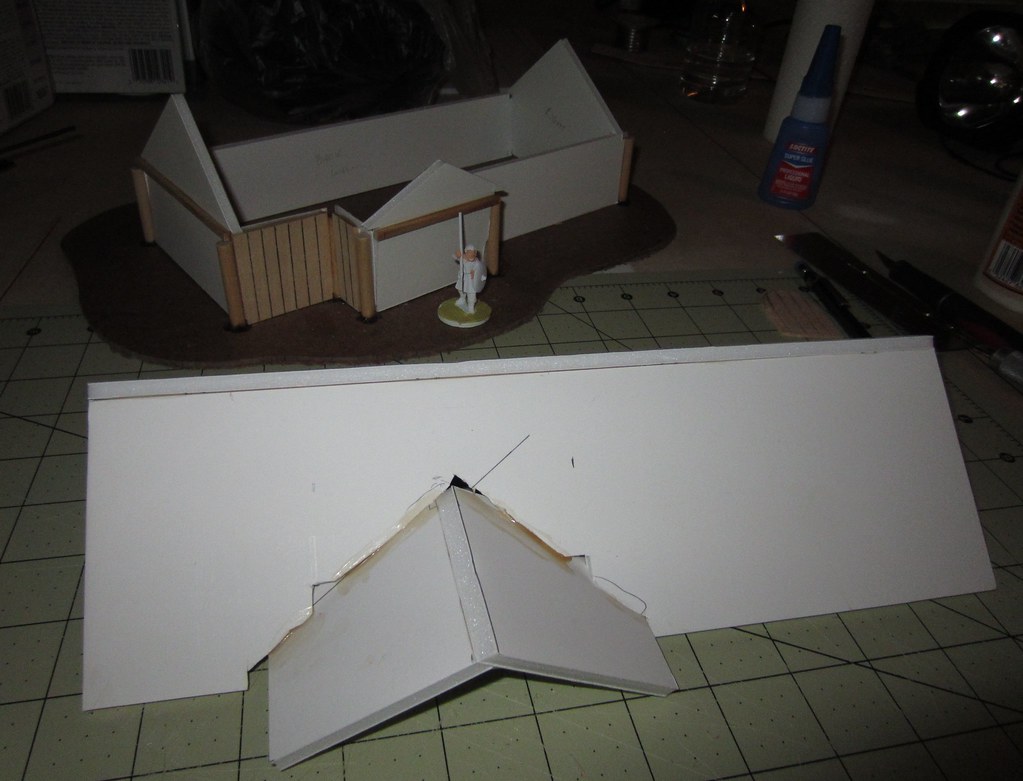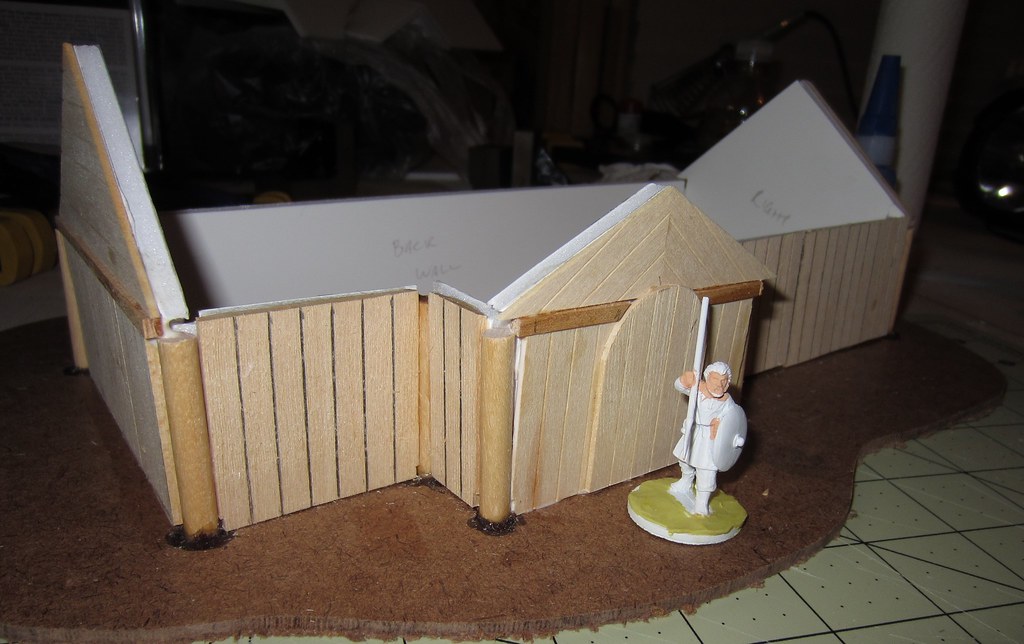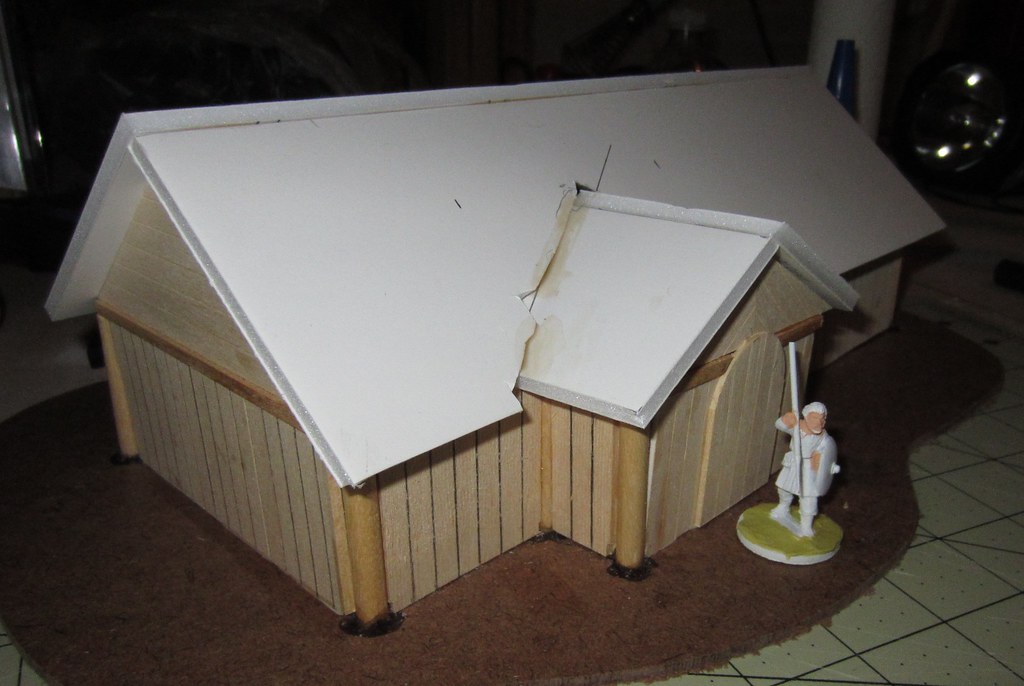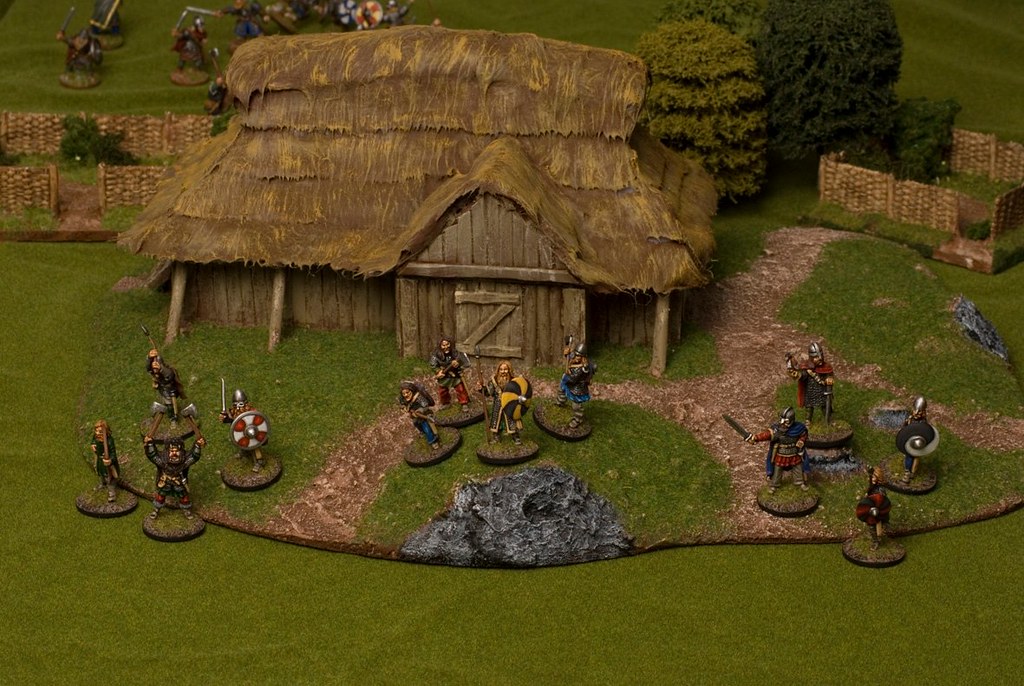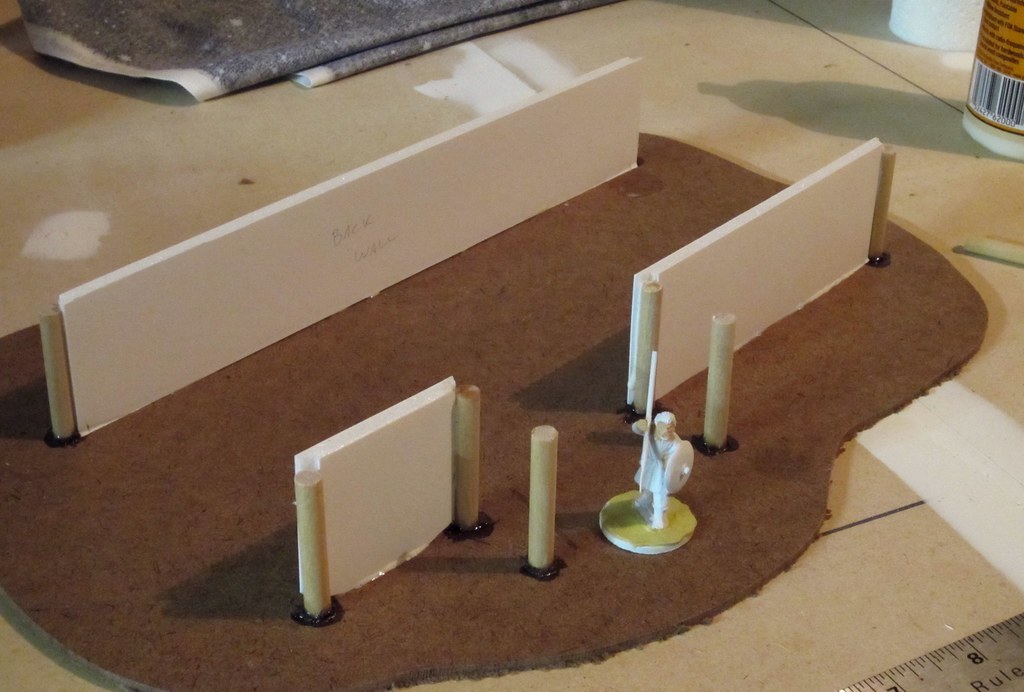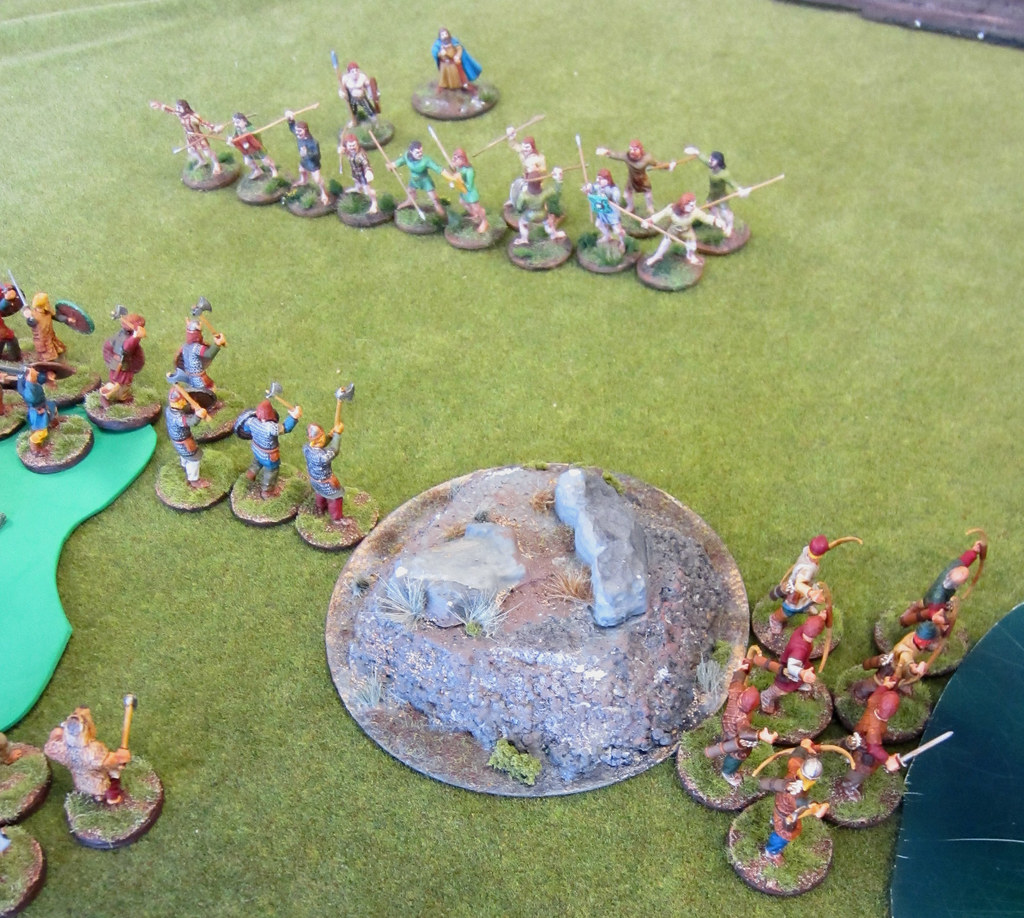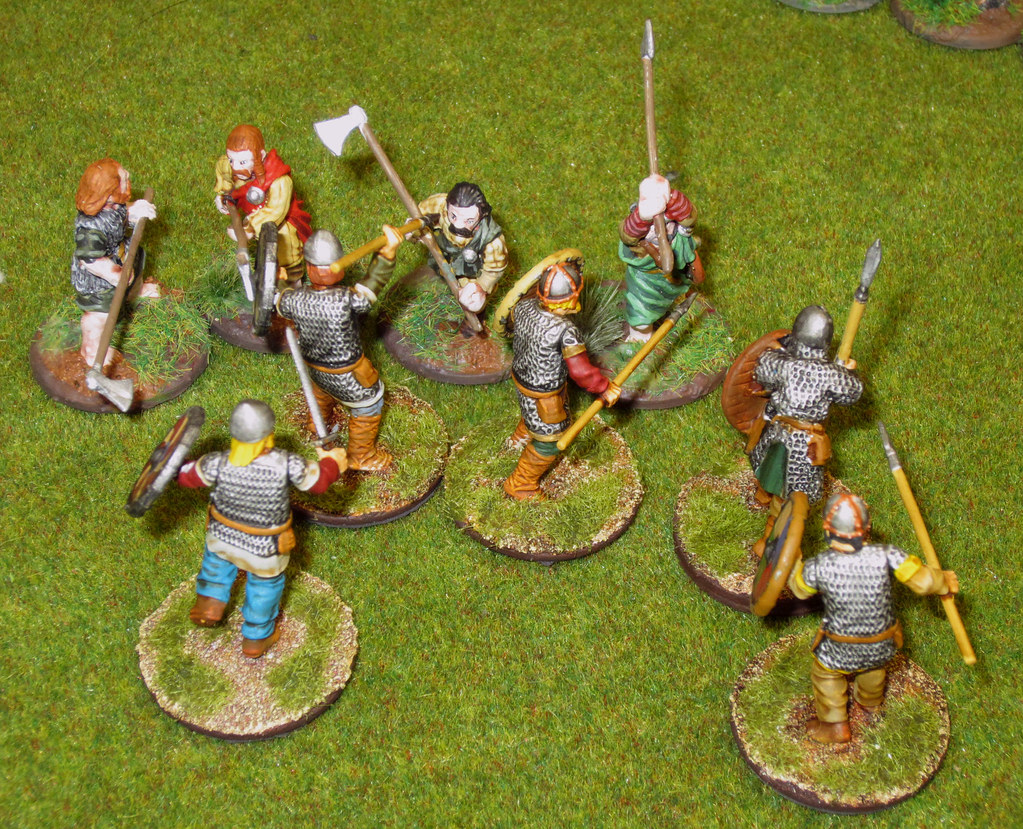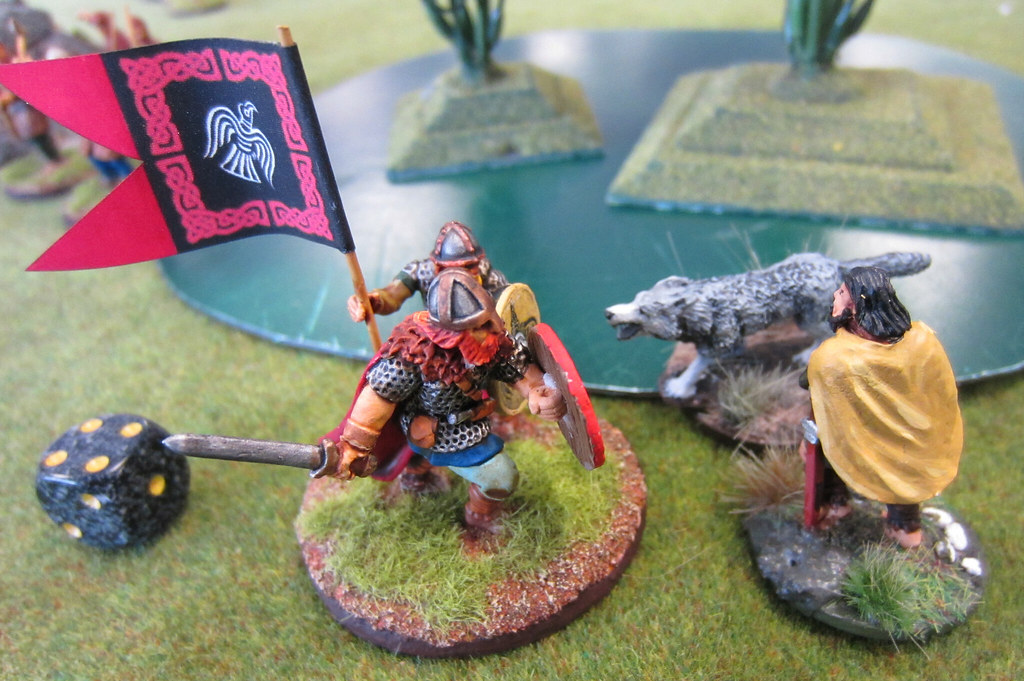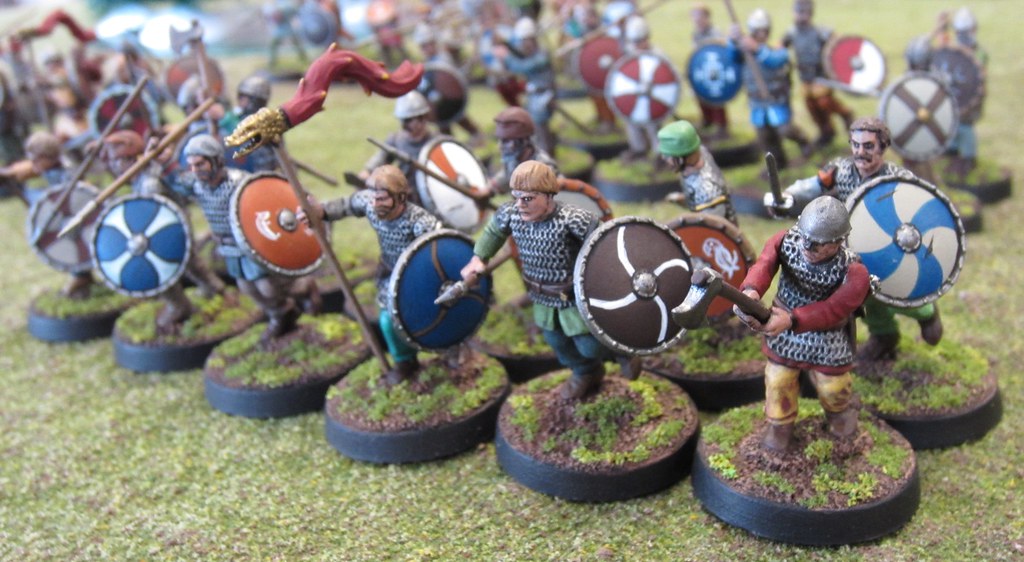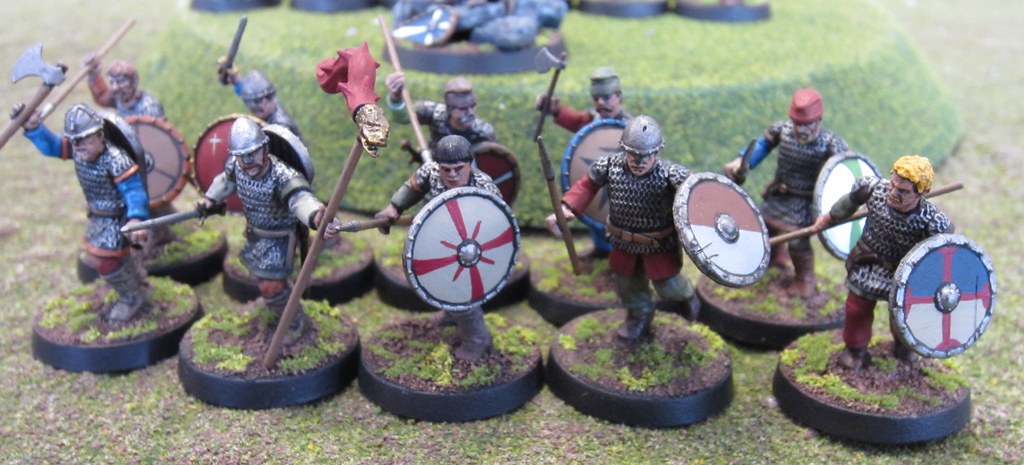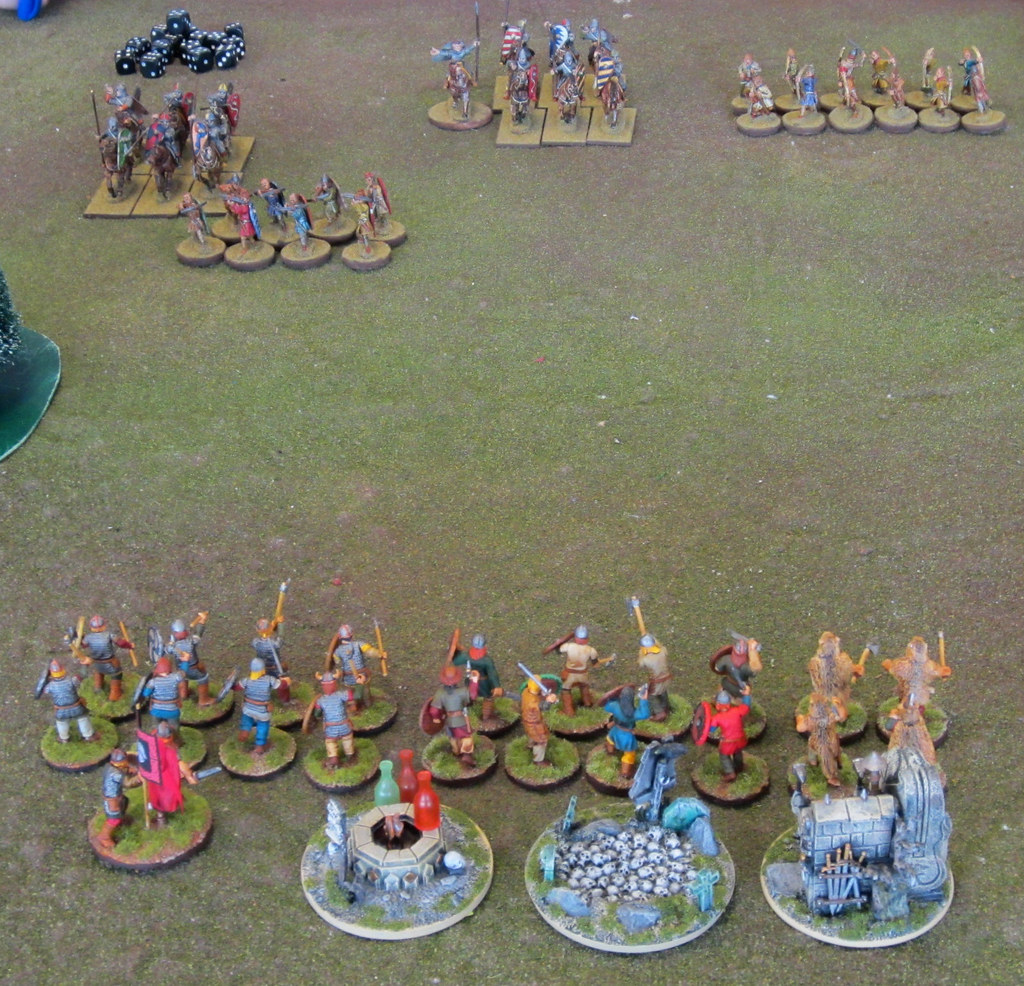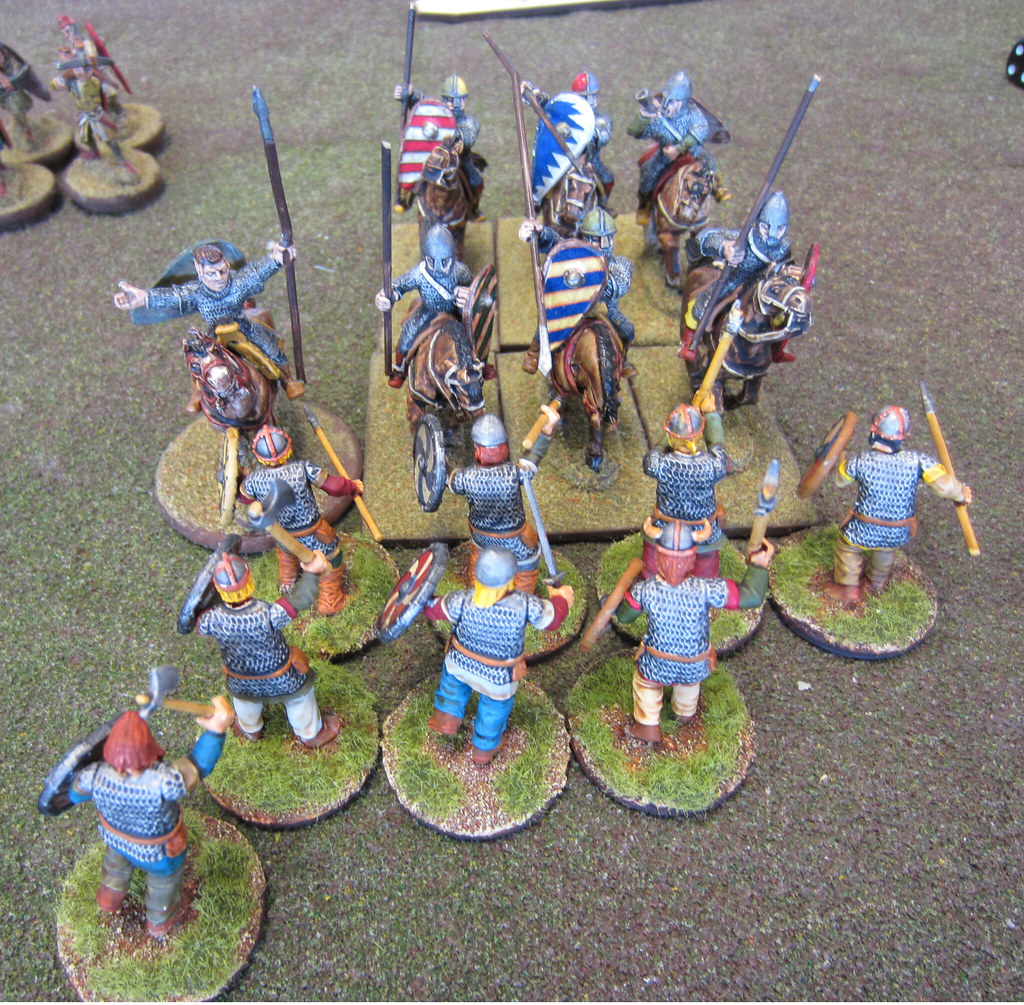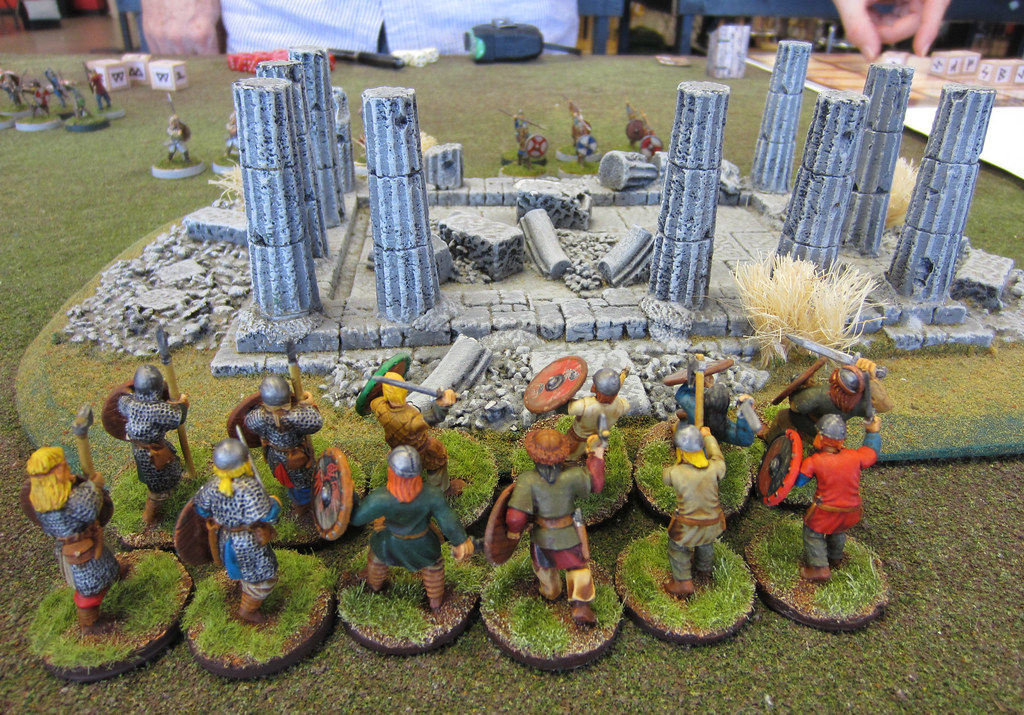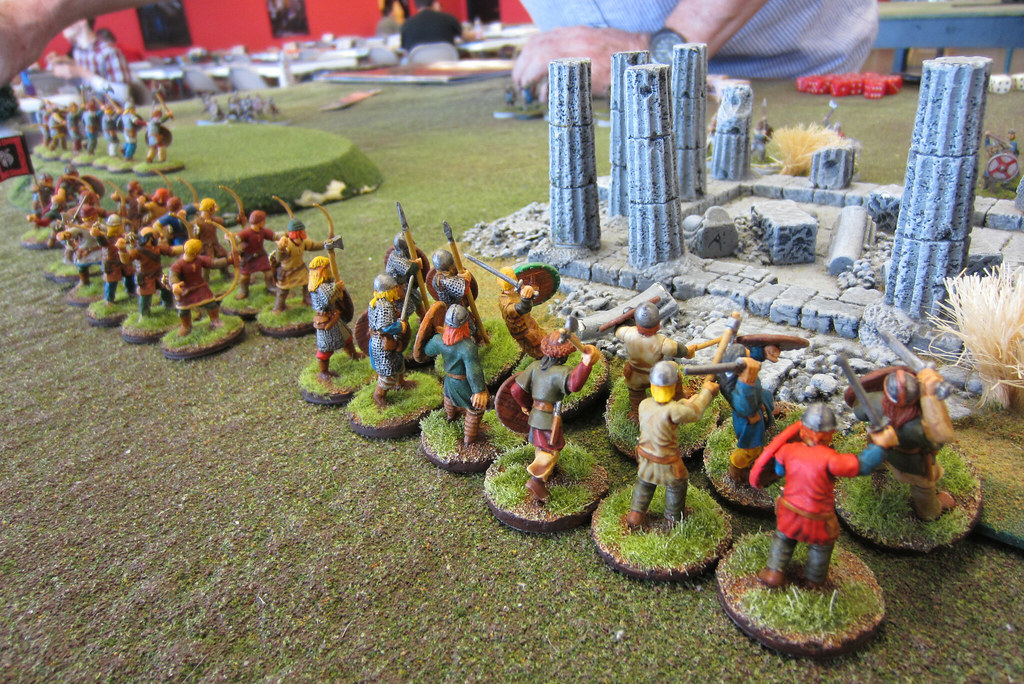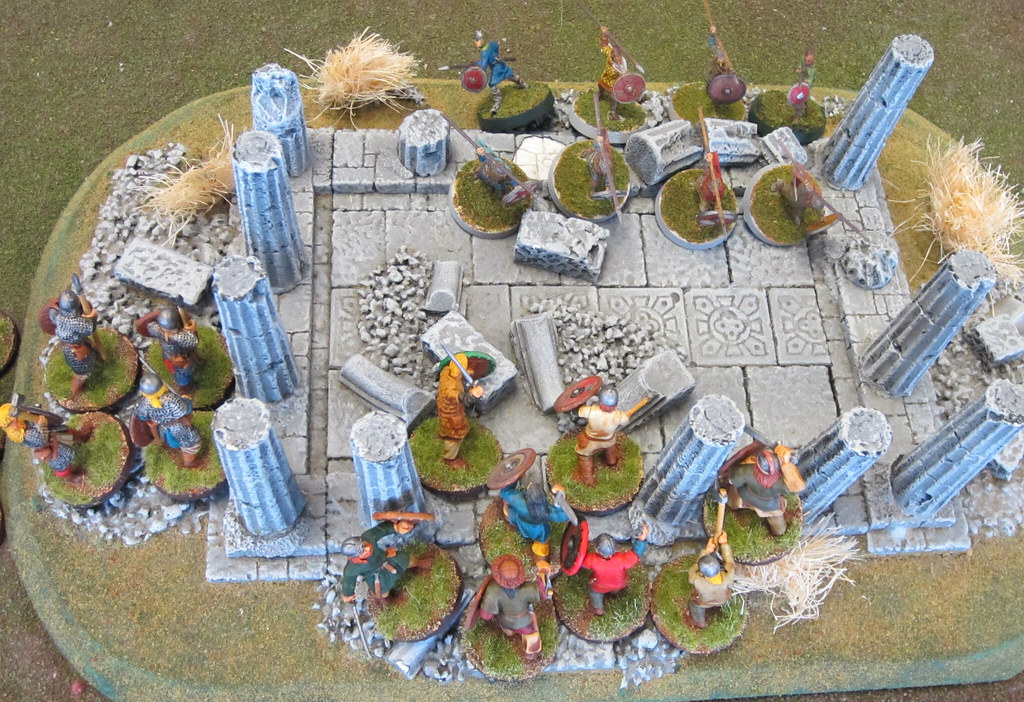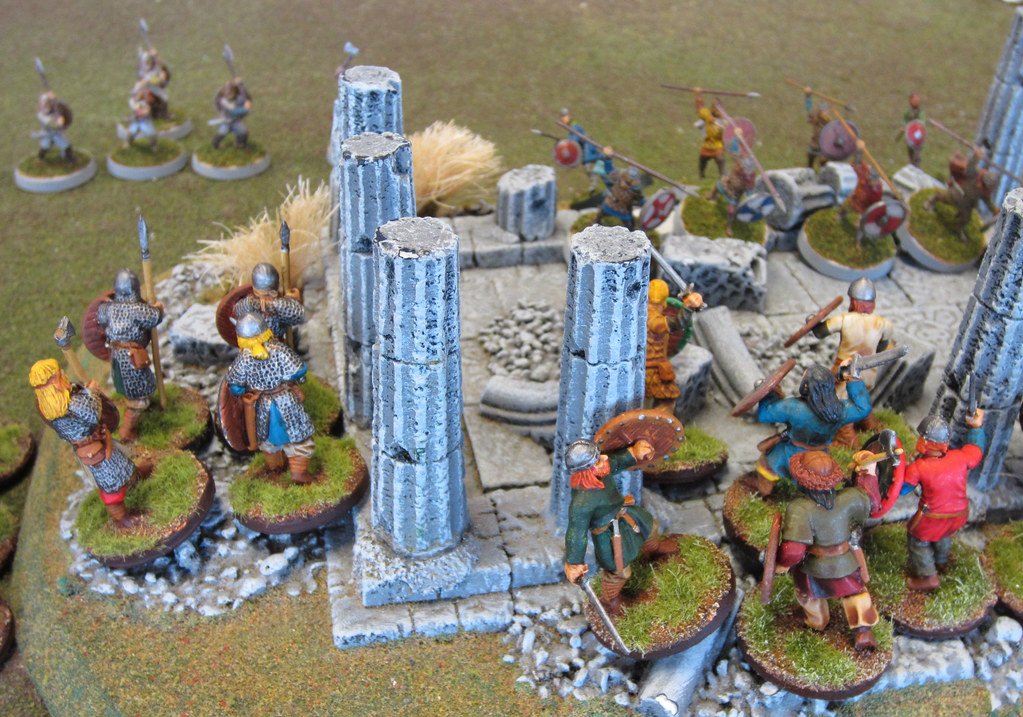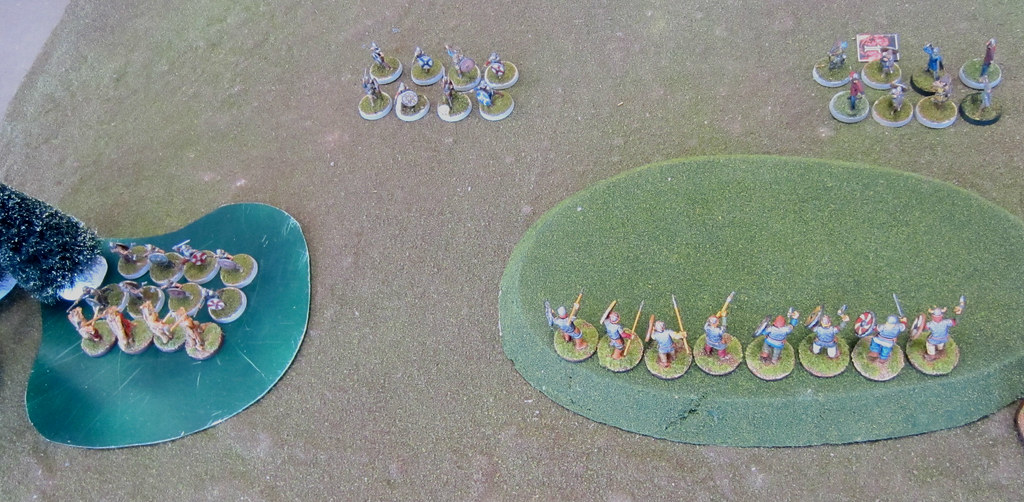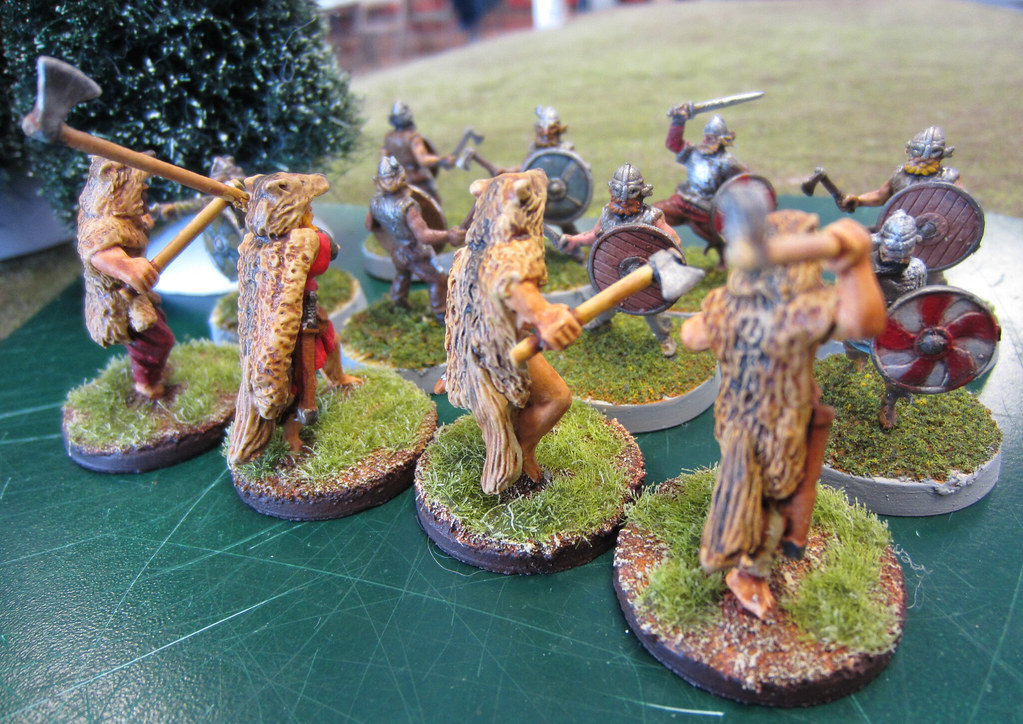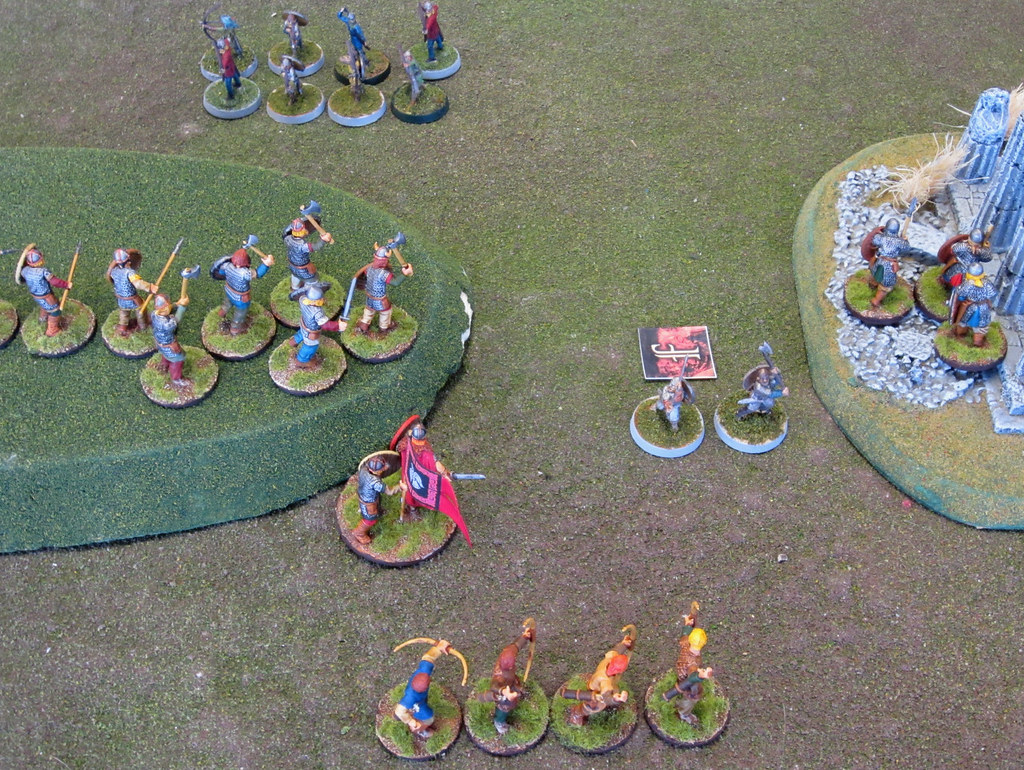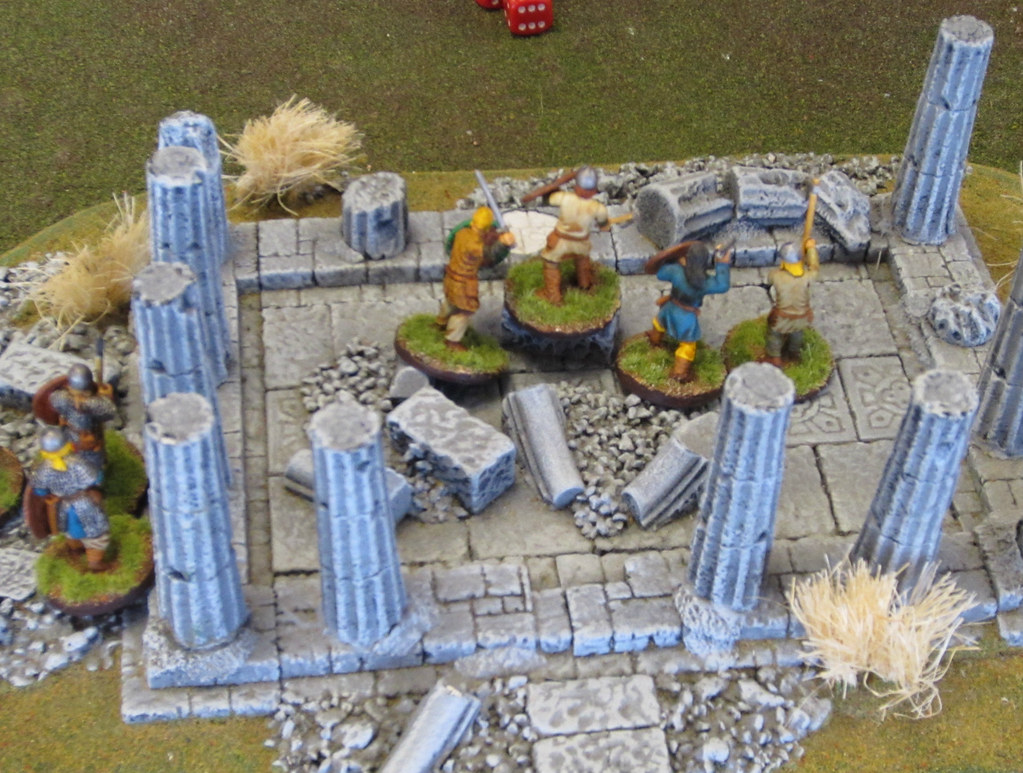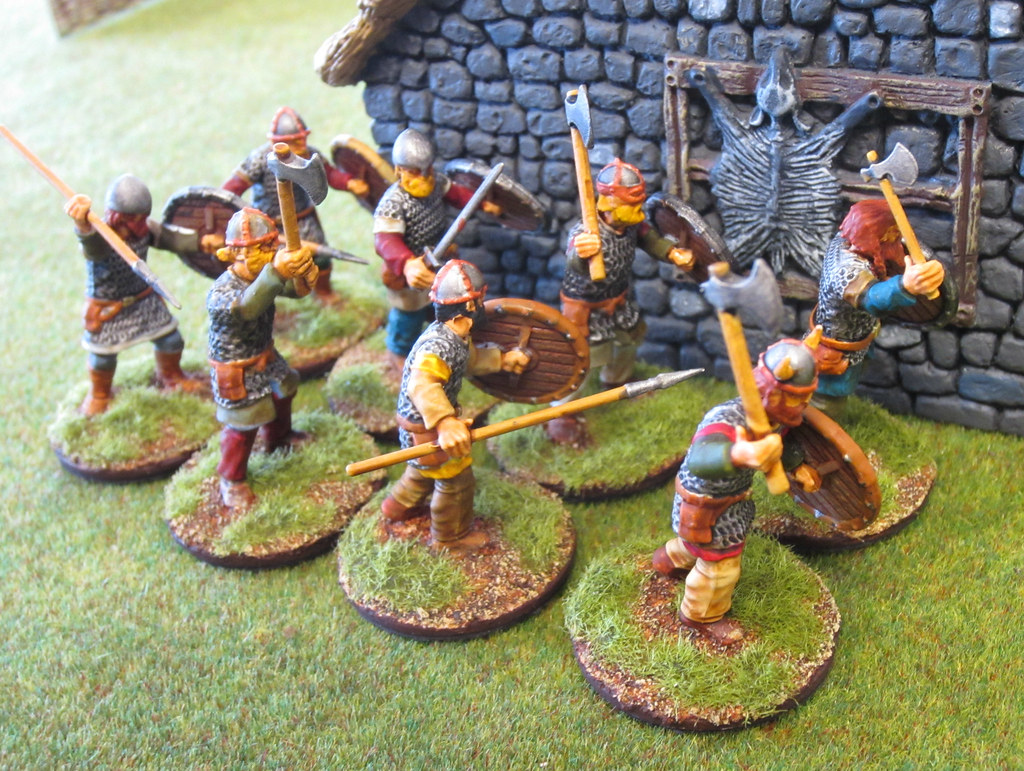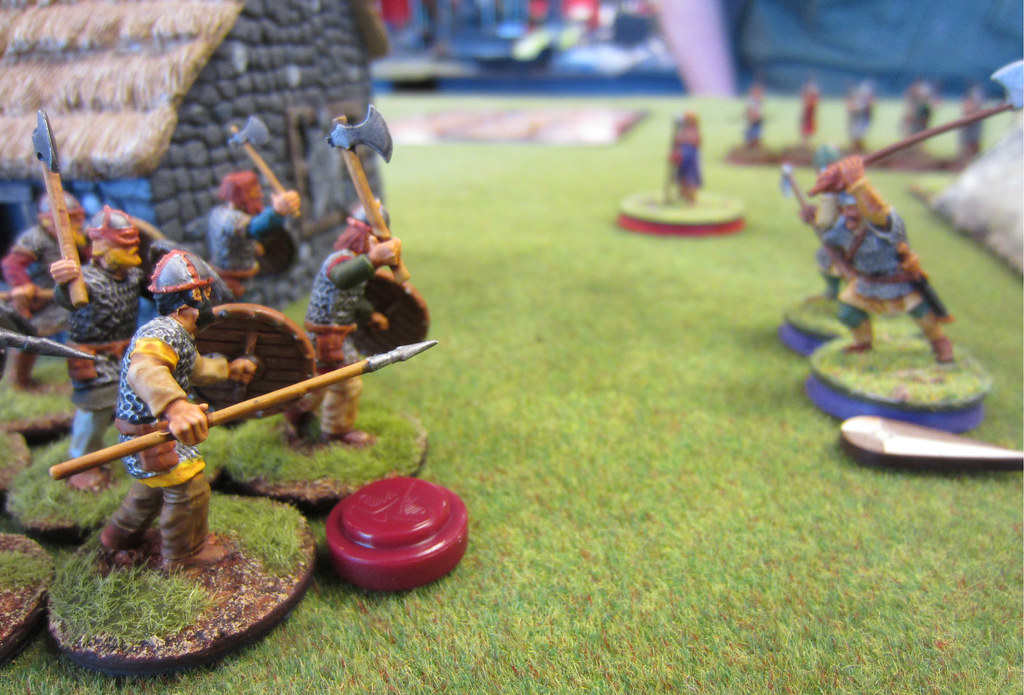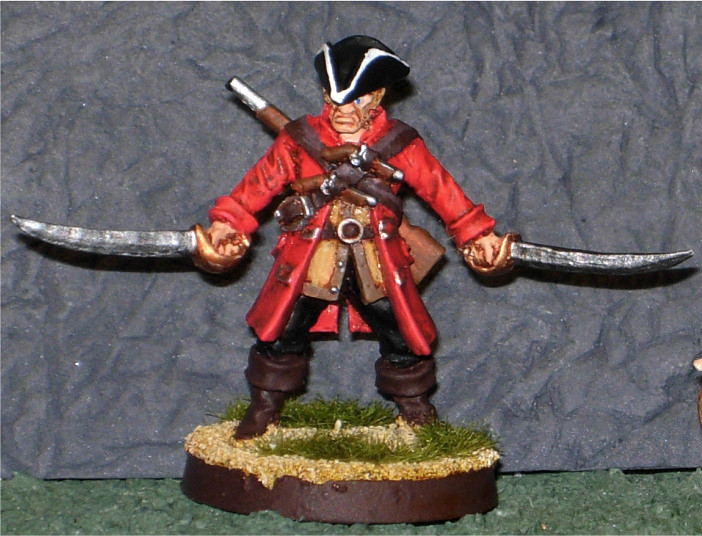Monday, September 29, 2014
Saga - Viking Hall - Thatched Roof and coat of primer!
I'm back with an update on the progress of my next Viking building.
Earlier posts detailed the initial steps:
Unfortunately, I did not feel well for part of the weekend, so I did not get as far as I wanted. But, I was able to finish construction, and get the building primed in preparation for painting and landscaping.
Using more of my bargain-bin teddy bear fur, I completed the thatching on the roof. I cut the material into strips about an inch or so wide, making sure the grain of the fur ran across the width of the strips. I also cut back the material backing along the bottom strip, leaving some of the fur overhanging the roof to give it a rougher look. I think it came out looking pretty good. And the nice thing is that I still have a LOT of that ugly green fur to make more buildings. I think I paid about $3 for a yard of material.
After the material was glued down, I brushed on a water-down PVA mixture over the entire thatch, then left it to dry overnight. I used less glue than on my first building, and it dried in just a day, rather than take several days like the last time.
The other thing I did in preparation for spraying the primer, was to coat all the exposed edges of foamcore with glue (I used carpenter's glue). Since spray paint often melts foam, I wanted to add a layer of protection of possible.
Once the roof and glue were completely dry, I sprayed the entire thing. Since the building is mostly of wood construction, I used a flat brown Rustoleum spray from Wal-mart. Once this dries, I will give it some shading, drybrush highlight, and call it done.
While I was at it, I took the opportunity to prime another building. This one is a pre-made medieval building that I got for my birthday (thanks David!) and appears to be a barn or storehouse. It's a one-piece cast of a very dense foam (I don't think it's resin). I used a lighter tan for this on, since it's of mud-covered wattle construction. The base may not fix exactly with a Dark Ages theme, but I think it'll be okay. I am not a stickler. Plus, this gives me a third building so that I'll have enough to play the Homeland scenario without having to borrow terrain.
Hopefully, I'll be able to get these finished up this week so I can move onto other projects.
'Til next time!
Wednesday, September 24, 2014
Saga - progress on my Viking hall!
Last time I posted about my Viking hall, the walls were not quite up for the entire building. Fortunately, I've had several days to work on it and make some more progress.
First I measured and cut the ends of the building, and the short wall where the door will be. These were not glued in place yet, simply placed to make sure they'd fit.
I was debating how to do the roof - whether or not to make it removable. Ease of construction vs being able to put troops actually inside the building during games... In the end I decided to make a lift-off roof. I measured and cut the foamcore, and glued it together. This required a lot of test fitting and trimming to get right.
Here you can see that the roof is, indeed, removable. Don't worry about the gaps. While they are larger than I hoped, they'll be completely covered by the teddy bear fur I will use as thatching.
I used balsa wood for the wooden walls. I scribed lines, using a pencil, every 1/4 inch. I also scraped a saw blade edgewise along the wood, to give it a "grain." While this is not visible in the photos, I am hoping it comes out nice after I paint and stain the walls.
Here you can see the completed walls (the one wall that isn't done yet is the rear wall). Having the roof on the building give a good indication of what the hall will look like when it is complete.
The next steps will be completing the wood on the back of the building, and gluing the fur thatching on the roof. After that, just the landscaping and painting. Hopefully it will be done within the next week or so, but as always, we'll see how "real life" impacts that schedule.
'Til next time!
First I measured and cut the ends of the building, and the short wall where the door will be. These were not glued in place yet, simply placed to make sure they'd fit.
I was debating how to do the roof - whether or not to make it removable. Ease of construction vs being able to put troops actually inside the building during games... In the end I decided to make a lift-off roof. I measured and cut the foamcore, and glued it together. This required a lot of test fitting and trimming to get right.
Here you can see that the roof is, indeed, removable. Don't worry about the gaps. While they are larger than I hoped, they'll be completely covered by the teddy bear fur I will use as thatching.
I used balsa wood for the wooden walls. I scribed lines, using a pencil, every 1/4 inch. I also scraped a saw blade edgewise along the wood, to give it a "grain." While this is not visible in the photos, I am hoping it comes out nice after I paint and stain the walls.
Here you can see the completed walls (the one wall that isn't done yet is the rear wall). Having the roof on the building give a good indication of what the hall will look like when it is complete.
The next steps will be completing the wood on the back of the building, and gluing the fur thatching on the roof. After that, just the landscaping and painting. Hopefully it will be done within the next week or so, but as always, we'll see how "real life" impacts that schedule.
'Til next time!
Sunday, September 21, 2014
A review of Saga: The Crescent & The Cross
Last week, while I was at Giga-Bites for the Saga tournament, I purchased the new Saga rulebook.
Saga: The Crescent & The Cross (abbreviated SC&C throughout this post) is the latest installment in the Saga family, but is a huge departure from the previous supplements.Where the other additions gave rules for new warbands to be used with the original Saga rules (abbreviated SDA throughout this post for Saga Dark Ages), this volume takes the world of Saga forward in time to the age of the Crusades!
What SC&C is and what it isn't:
Before even picking up the book, you'll notice two obvious differences. First, SC&C is a hardcover tome, unlike the previous softcover SDA rules and supplements. Second, is the higher price. The new book lists for $48, versus the $40 price tag on the original. (Spoiler alert: In my opinion, the book is well worth the extra money!)
As you begin to leaf through the book, you'll notice some other differences.
First is the page count - a whopping 120 pages! This compares to the 74 pages of SDA.
You'll also notice the layout - they've used a ton of photos, drawings and diagrams to illustrate this book. While this is one reason for the higher page count, I am all for it. I love seeing photos of beautifully painted models (and this book is full of them!) to inspire me and show me what can be achieved. I can't tell you how many times I've seen a photo and thought, "I can do that!" and headed off to my modelling cave to crank out a figure or piece of scenery.
Speaking of drawings, the book is full of magnificent illustrations by Peter Dennis, reminiscent of what you'd find in an Osprey book. One thing that caught my eye, is that some illustrations directly relate to the photographs of models. Check out the drawing of the Crusader on page 67, and look at the top right figure in the photo on page 66. Look carefully at the shield and pennant. Yep, same guy!
When it comes to the rules themselves, SC&C introduces us to a new teacher, and reintroduces an old friend.
Hashim Ibn Khalid Ibn Abad pops up whenever there's a particular point to stress, or to give examples throughout the book.
Ragnar, our intrepid guide from SDA, is back. For longtime Saga players, seeing his image means "Pay attention!" His presence indicates a place where the new rules expand upon or differ from the SDA. Frankly, even if I never get to play a game using the new warbands, the book is worth buying just for the streamlined and improved rules. (Who am I kidding? I am already planning a Spanish warband!)
Another addition is the use of red text to highlight important points in the rules.
The rules have been revised and expanded since SDA, and they are laid out in a more logical fashion than in the earlier book. For example, the section on attack rolls went from one long paragraph in SDA, to four paragraphs in SC&C that better explain exactly what happens in that phase of the melee. Terrain rules were laid out in two pages in SDA, but they take up four pages of SC&C. This expansion is another factor in the page count, but again, I think it is a huge improvement.
Perhaps the most important expansion comes in the section on Saga abilities, as the use of these abilities is arguably the heart and soul of the Saga system. In SDA, the Abilities rules took up one page, before going straight into a description of the various abilities. In SC&C you have a full three pages devoted to Saga Abilities, with a very detailed and useful explanation devoted to timing, i.e., in what part of the turn sequence can you use each type of ability.
Another improvement is in the organization of the rules. To offer just one example: In the SDA rules, under Shooting, there is no mention at all that the defender can use his opponent's fatigue to affect the results. That fact is only mentioned in the Fatigue section. In SC&C, that information sensibly appears in both the Shooting section and the Fatigue section.
As previously mentioned, some of the expanded rules and clarification that were missing in the original SDA, but were added in the Raven's Shadow expansion, are included in these new rules.
Two examples (of many):
One rule I take issue with is how disengagement is handled when the losing side cannot retreat. According to the new rules, if neither the losing nor winning side can disengage via a legal move, the Attacker is wiped out. The author himself says in the book that this "reeks of cheese." If even the author feels that way, I wonder why he did not change it. In this instance I can see, and will seriously consider, a house rule that when neither side can disengage, the loser (whether it be the attacker or defender) is wiped out.
A couple of new sections of the rules are worth noting:
The factions are:
Following the factions is a listing of Dogs of War - units of mercenaries and additional troops with special weapons and/or abilities that can be added to your warband.
Six new Scenarios close out the rules, giving you more options for playing games of Saga.
In addition to the book, you get six beautiful full-color battle boards, one for each of the new factions, and a Quick Reference Sheet. The battle boards have been redesigned, and in my opinion the changes are all for the better.
The battle boards appear to be the same nice thickness of the boards that come with SDA, perhaps a tiny bit thicker. They have a matte finish, rather than the glossy finish of the SDA boards. They are a lighter color, which IMO makes them easier to read. Also, the abilities that are common to all factions and can be used multiple times per turn are grouped above the name of the faction, rather than down the left side as in the older SDA boards. This sets them apart very graphically, and screams "Treat these abilities differently!" The abilities that are restricted to once per turn are grouped below the faction name. I like the new battleboard layout a lot.
SC&C includes a separate Quick Reference Sheet, rather than having it printed in the book. In my opinion, the QRS is the one glaring weakness in this product. The QRS is printed on a very thin sheet of glossy paper, like a page from a magazine. It would have been much better to print this on a card sheet, the same as the battle boards, to make it more durable.
There are some other small points that detract from SC&C, some small editing issues where the translation from French to English is awkward, and at least one case of a mistake in one of the examples (which is minor in that the mistake does not impact the point being made).
Overall impression: I was very impressed with SC&C. It is obvious that Studio Tomahawk/Gripping Beast not only heard what was said about the original version, but took it to heart. They made changes, not just for the sake of making the new book different, but with the intent of making it better. And they succeeded!
I give Saga: The Crescent & The Cross...
Nine out of ten Crusader shields!
The only things that kept SC&C from being perfect and earning the tenth shield, frankly, are the flimsy Quick Reference Sheet and the minor editing mistakes.
As previously mentioned, this book is well worth the price, and in my opinion is a must-have addition to the library of anyone who already has the SDA rules. And if you don't.... well, what are you awaiting for? SC&C is the perfect way to jump into the great gaming experience that is Saga.
'Til next time!
Saga: The Crescent & The Cross (abbreviated SC&C throughout this post) is the latest installment in the Saga family, but is a huge departure from the previous supplements.Where the other additions gave rules for new warbands to be used with the original Saga rules (abbreviated SDA throughout this post for Saga Dark Ages), this volume takes the world of Saga forward in time to the age of the Crusades!
What SC&C is and what it isn't:
- It is not a supplement for the original Saga rules.
- It is a complete, new, stand-alone set of rules for playing Saga in either the Dark Ages or the Crusades era.
- It is not just the same old Saga with a different flavor.
- It is an updated version of the Saga rules that incorporates the erratas and FAQs from SDA, and the rules in SC&C replace the rules in SDA.
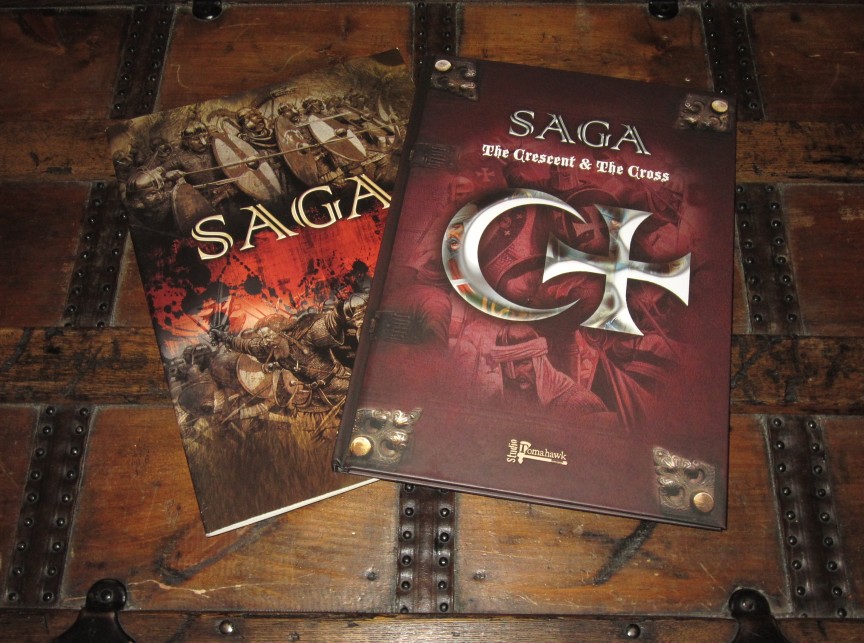 |
| The two Saga rulebooks, side by side. |
Before even picking up the book, you'll notice two obvious differences. First, SC&C is a hardcover tome, unlike the previous softcover SDA rules and supplements. Second, is the higher price. The new book lists for $48, versus the $40 price tag on the original. (Spoiler alert: In my opinion, the book is well worth the extra money!)
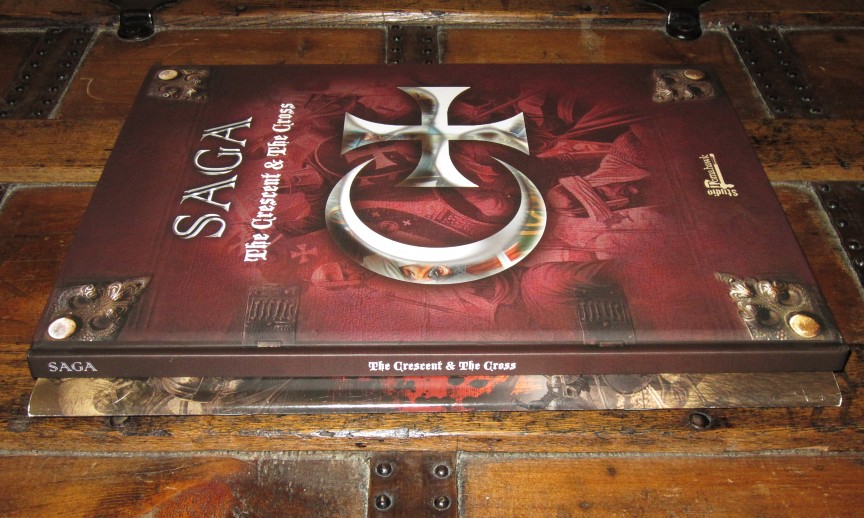 |
| The older rulebook for Saga is on the bottom. |
As you begin to leaf through the book, you'll notice some other differences.
First is the page count - a whopping 120 pages! This compares to the 74 pages of SDA.
 |
| The tables of content show the difference in page count. |
You'll also notice the layout - they've used a ton of photos, drawings and diagrams to illustrate this book. While this is one reason for the higher page count, I am all for it. I love seeing photos of beautifully painted models (and this book is full of them!) to inspire me and show me what can be achieved. I can't tell you how many times I've seen a photo and thought, "I can do that!" and headed off to my modelling cave to crank out a figure or piece of scenery.
Speaking of drawings, the book is full of magnificent illustrations by Peter Dennis, reminiscent of what you'd find in an Osprey book. One thing that caught my eye, is that some illustrations directly relate to the photographs of models. Check out the drawing of the Crusader on page 67, and look at the top right figure in the photo on page 66. Look carefully at the shield and pennant. Yep, same guy!
When it comes to the rules themselves, SC&C introduces us to a new teacher, and reintroduces an old friend.
Hashim Ibn Khalid Ibn Abad pops up whenever there's a particular point to stress, or to give examples throughout the book.
Ragnar, our intrepid guide from SDA, is back. For longtime Saga players, seeing his image means "Pay attention!" His presence indicates a place where the new rules expand upon or differ from the SDA. Frankly, even if I never get to play a game using the new warbands, the book is worth buying just for the streamlined and improved rules. (Who am I kidding? I am already planning a Spanish warband!)
Another addition is the use of red text to highlight important points in the rules.
The rules have been revised and expanded since SDA, and they are laid out in a more logical fashion than in the earlier book. For example, the section on attack rolls went from one long paragraph in SDA, to four paragraphs in SC&C that better explain exactly what happens in that phase of the melee. Terrain rules were laid out in two pages in SDA, but they take up four pages of SC&C. This expansion is another factor in the page count, but again, I think it is a huge improvement.
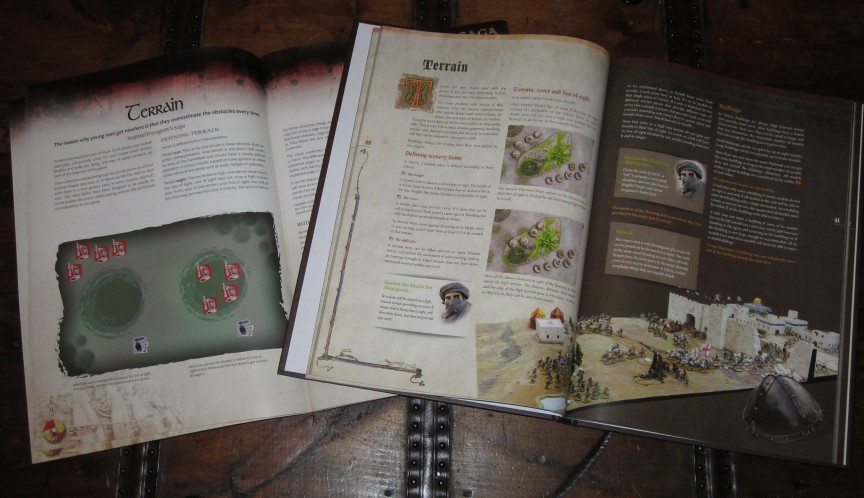 |
| Example of the new terrain rules and teh older ones (left). |
Perhaps the most important expansion comes in the section on Saga abilities, as the use of these abilities is arguably the heart and soul of the Saga system. In SDA, the Abilities rules took up one page, before going straight into a description of the various abilities. In SC&C you have a full three pages devoted to Saga Abilities, with a very detailed and useful explanation devoted to timing, i.e., in what part of the turn sequence can you use each type of ability.
Another improvement is in the organization of the rules. To offer just one example: In the SDA rules, under Shooting, there is no mention at all that the defender can use his opponent's fatigue to affect the results. That fact is only mentioned in the Fatigue section. In SC&C, that information sensibly appears in both the Shooting section and the Fatigue section.
As previously mentioned, some of the expanded rules and clarification that were missing in the original SDA, but were added in the Raven's Shadow expansion, are included in these new rules.
Two examples (of many):
- The Melee phase now includes a Step 0 in which Melee/Reaction abilities are used.
- Certain units can have optional War Banners.
One rule I take issue with is how disengagement is handled when the losing side cannot retreat. According to the new rules, if neither the losing nor winning side can disengage via a legal move, the Attacker is wiped out. The author himself says in the book that this "reeks of cheese." If even the author feels that way, I wonder why he did not change it. In this instance I can see, and will seriously consider, a house rule that when neither side can disengage, the loser (whether it be the attacker or defender) is wiped out.
A couple of new sections of the rules are worth noting:
- Rules for using special weapons (bows, javelins, crossbows, heavy weapons, etc) are detailed in the Armoury, which conveniently keeps them all in one place. The Armoury also has rules for mounted troops, including those riding on camels!
- The Priest, which as Ragnar helpfully points out can also be added to SDA games, adds rules for fielding a religious leader with your warband. He can be either an additional hero, or take the place of your warlord. I am eager to try these out in both SDA and SC&C games.
The factions are:
- Crusaders
- Saracens
- Milites Christi
- Mutatawwi'a
- Spanish
- Moors
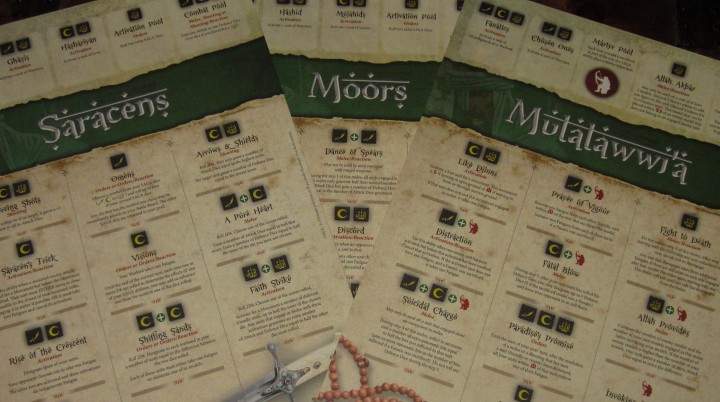 |
| The Muslim factions' battle boards. |
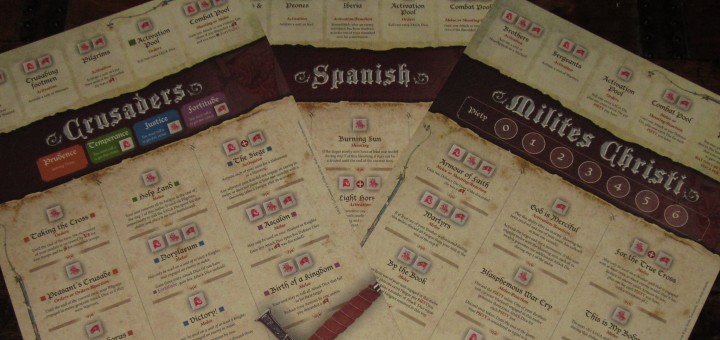 |
| The Christian factions' battle boards. |
Following the factions is a listing of Dogs of War - units of mercenaries and additional troops with special weapons and/or abilities that can be added to your warband.
Six new Scenarios close out the rules, giving you more options for playing games of Saga.
In addition to the book, you get six beautiful full-color battle boards, one for each of the new factions, and a Quick Reference Sheet. The battle boards have been redesigned, and in my opinion the changes are all for the better.
The battle boards appear to be the same nice thickness of the boards that come with SDA, perhaps a tiny bit thicker. They have a matte finish, rather than the glossy finish of the SDA boards. They are a lighter color, which IMO makes them easier to read. Also, the abilities that are common to all factions and can be used multiple times per turn are grouped above the name of the faction, rather than down the left side as in the older SDA boards. This sets them apart very graphically, and screams "Treat these abilities differently!" The abilities that are restricted to once per turn are grouped below the faction name. I like the new battleboard layout a lot.
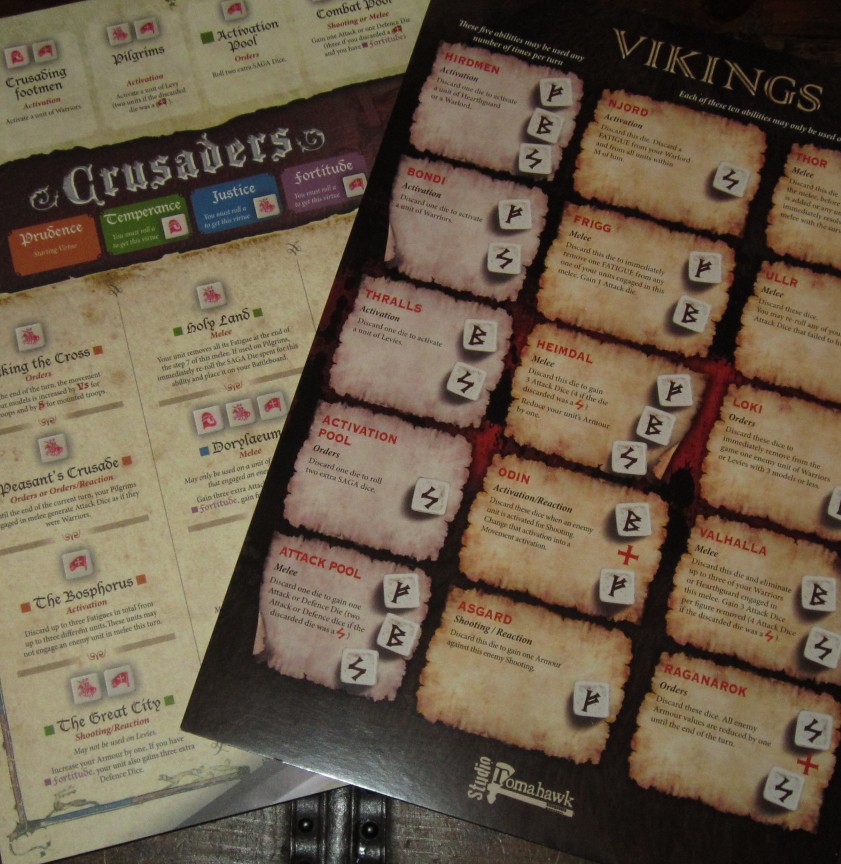 |
| The older, shiny battle board is on the right. |
SC&C includes a separate Quick Reference Sheet, rather than having it printed in the book. In my opinion, the QRS is the one glaring weakness in this product. The QRS is printed on a very thin sheet of glossy paper, like a page from a magazine. It would have been much better to print this on a card sheet, the same as the battle boards, to make it more durable.
There are some other small points that detract from SC&C, some small editing issues where the translation from French to English is awkward, and at least one case of a mistake in one of the examples (which is minor in that the mistake does not impact the point being made).
Overall impression: I was very impressed with SC&C. It is obvious that Studio Tomahawk/Gripping Beast not only heard what was said about the original version, but took it to heart. They made changes, not just for the sake of making the new book different, but with the intent of making it better. And they succeeded!
I give Saga: The Crescent & The Cross...
Nine out of ten Crusader shields!
The only things that kept SC&C from being perfect and earning the tenth shield, frankly, are the flimsy Quick Reference Sheet and the minor editing mistakes.
As previously mentioned, this book is well worth the price, and in my opinion is a must-have addition to the library of anyone who already has the SDA rules. And if you don't.... well, what are you awaiting for? SC&C is the perfect way to jump into the great gaming experience that is Saga.
'Til next time!
Friday, September 19, 2014
Saga - another building in progress
As I've already posted here, my Vikings finished second in the Saga tournament held at Giga-Bites Cafe on September 13. Since they fought so hard, I was thinking about doing something nice for them (in addition to painting up the last two points of warriors) when I came across this image on Valhalla's Facebook page:
Perfect! I'd give them a hall to sit around and drink mead in, recounting the tales of their brave deeds! Inspired by the image, I began to plan the new addition to my Viking village. No doubt this will slow my already slow painting progress even more, but I think it's worth it.
This building is going to be a large hall, so it'll have a footprint about twice as large as my previous Viking dwelling. It will definitely be treated as a large building in Saga, capable of holding 12 models.
I want it to look impressive, and have a different style of construction to the other building, to make it distinct, and mark it as Jarl Einric Stormraven's home.
I made a couple of quick sketches to get an idea of how big it should be and how it might look, and then it was time to begin construction!
Rather than wait until the building is complete, I want to post images and information as I go along.
Here's the first installment...
Step 1: Cut the MDF board to size for the base, drill holes for the supporting posts, and glue them in place. I used 1/4" dowel for the posts. Make sure that the posts are as vertical as possible, since they will mark the corners of the building.
Step 2: Begin placement of the walls between the posts. I'm using foamcore for the walls, which will be covered with wooden coffee stirrers later to represent the wooden walls of the building.
I still have not decided if I am going to make the roof removable. A lift-off roof makes it easier to show there's a unit in the building during gameplay, but it also complicates construction. I will post more photos in the coming days as I continue work on this latest project.
'Til next time!
Perfect! I'd give them a hall to sit around and drink mead in, recounting the tales of their brave deeds! Inspired by the image, I began to plan the new addition to my Viking village. No doubt this will slow my already slow painting progress even more, but I think it's worth it.
This building is going to be a large hall, so it'll have a footprint about twice as large as my previous Viking dwelling. It will definitely be treated as a large building in Saga, capable of holding 12 models.
 |
| My first Viking building. |
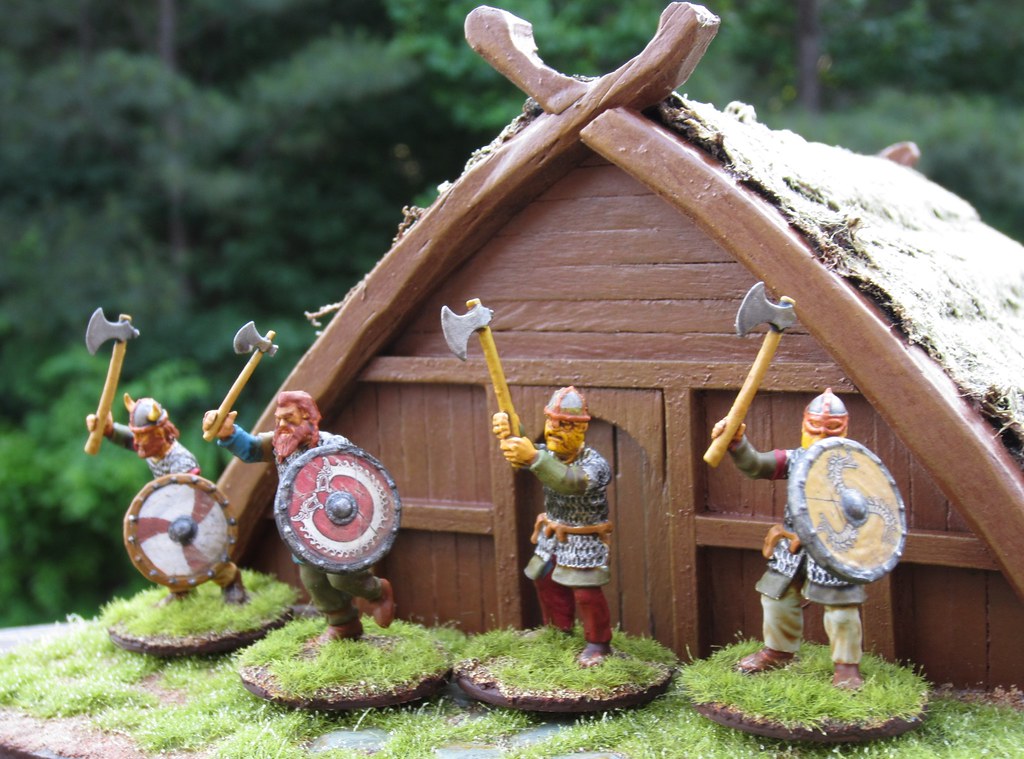 |
| Hirdmen protect the dwelling (shown for scale). |
I want it to look impressive, and have a different style of construction to the other building, to make it distinct, and mark it as Jarl Einric Stormraven's home.
I made a couple of quick sketches to get an idea of how big it should be and how it might look, and then it was time to begin construction!
Rather than wait until the building is complete, I want to post images and information as I go along.
Here's the first installment...
Step 1: Cut the MDF board to size for the base, drill holes for the supporting posts, and glue them in place. I used 1/4" dowel for the posts. Make sure that the posts are as vertical as possible, since they will mark the corners of the building.
Step 2: Begin placement of the walls between the posts. I'm using foamcore for the walls, which will be covered with wooden coffee stirrers later to represent the wooden walls of the building.
I still have not decided if I am going to make the roof removable. A lift-off roof makes it easier to show there's a unit in the building during gameplay, but it also complicates construction. I will post more photos in the coming days as I continue work on this latest project.
'Til next time!
Tuesday, September 16, 2014
Saga tournament - part 2
Last time, I gave an overview of the Saga tournament held at Giga-Bites. This time, I will give a more detailed account of the day's events, focusing on my games using a Viking warband.
(tl;dr - Scroll down to the bottom to the Overall Lessons section, but I warn you - you'll miss all the fun!)
Based on Richard's instructions, we each brought a list of seven points worth of models. For each scenario, we selected our force from that list, with the number of points available determined by the particular set-up rules. Unfortunately, I only managed to get six points painted in time for the tourney.
In June, I ruptured my biceps tendon, requiring surgery to repair the injury.
Following surgery, I had to wear an immobilizing brace on my arm for six weeks.
With the brace on, I could paint some, but it as slow, tedious and tiring.
Not being able to bend my elbow made it quite uncomfortable to work. And I was not able to bring the miniature closer to me in order to see it better or reach parts of it more easily with the brush.
That was followed by weeks of physical therapy to regain my range of motion and strength. Soon after my recovery was complete, we took a family vacation to the beach to celebrate my parents' 50th wedding anniversary, and Krista's and my 20th!
The end result is that my painting time suffered greatly over the past months leading up to the tournament. I desperately wanted to have all seven points painted up and ready to go, but in the end I only got six points finished. I finished gluing the banner on my warlord after 11pm on the night before the tournament! I brought an unpainted seventh point of models to the tournament, but after seeing all the wonderfully painted models on the table, I just couldn't bring myself to field Vikings in that dreaded "snow camo" scheme - despite the fact they are from the cold, white north. So, I was handicapped slightly by only having a pool of six points to draw from during force selection.
Richard organized the tournament into four matches, each being a different scenario from the Saga rulebook. You could earn three points for a win, one for a draw, and nothing for a loss. Bonus points were available to be won in each scenario for achieving certain objectives. Also, we kept track of how many victory points of enemy models (per the rules on page 61) we killed, to use as a tiebreaker. This ended up being very important in the end...
Game 1 - Clash of Warlords
For the first game, I was matched up against Alan and his Irish army! Bonus points were available in this scenario for killing the enemy warlord, and for winning while losing 10 victory points or less of troops. Remember, victory points are not the same as points used to purchase units.
This was my first game ever against the sneaky Irish, so I had no idea what to expect from them. After placing the terrain, I deployed my forces concentrated towards the center-left, while Alan spread his out a little more.
I gained initiative (I think I won on the "beard" tiebreaker - there's something to be said for having more hair below your eyebrows than above them!). My first turn was spent moving up, and trying to determine what Alan's strategy would be and how best to counter it.
I did not have long to wait, as Alan advanced with his levy javelin throwers and started to try and whittle down my forces. Combined with the Sons of Dana battleboard ability which gives him a free shooting attack. this was quite annoying.
Over the course of the next several turns, Alan continued to gain victory points, while I fruitlessly chased his Irish levy. The Heirs of Mil ability is brutal! I couldn't charge or shot at his pesky javelin guys, and he kept placing them in very effective blocking positions to make it difficult for me to go around them and get to the rest of his forces.
Eventually, we did get to some melee combat, and it was a mixed bag for me. Alan ran his dogg unit around the left flank of my troops and came up from behind.
I detached my Berserkers to cut him off. In a brutal combat, the Berserkers were killed to the man, while the handler and one dogg survived.
I misinterpreted a rule, and limited my attack dice, which could possibly have meant that the units mutually wiped each other out. But Alan outplayed me enough that it would not have made a difference in the end result - I might have lost by fewer points, but still lost. He really made the most of the terrain and his abilities to slow down and harass my Vikings.
My eight-strong hearthguard unit (down to five men due to those infernal javelins) ran into his hearthguard, and there was much bloodletting on both sides.
My Viking warriors finally managed to charge into his levy, and I was able to wipe them out in a couple of turns of melee. This was too little, too late, and a waste of my troops, since the levy are worth so few victory points. Seeing them finally off the table was very satisfying, but ultimately did not help me much in terms of scoring.
Finally, in the end phase of the battle, I charged my warlord against the handler and surviving dogg, trying to score some last-minute points. Alan countered with The Old Ways. which limited my warlord to rolling two dice, the same as the dogg and handler! My dice abandoned me, and the warlord was slain.
Despite the loss, this was a very enjoyable game. Alan is a great opponent who is pleasant to play against even when he is pounding your army mercilessly. As usual, I learn more from a loss than from a win, and Alan taught me a lot in this game!
Lessons: Choose as little terrain as possible in games against the Irish! This limits their ability to use Sons of Dana.
And, as annoying as the Irish levy can be, scampering this way and that, peppering you with javelins and being immune to counterattack with the Heirs of Mil ability, they're still worth just 1 pt per three models - stay on target and focus on killing off the high-value units.
The Viking ability Odin doesn't do anything against javelins, since it turns a shooting activation into movement. Firing javelins happens as part of a movement activation, not a separate shooting activation, so they still get to throw their pointy sticks at you!
Result: A victory for the Irish, 20 vp to14 vp. Alan also got a bonus point for killing my warlord. After round one, I was 0-1 with zero points. The day could only get better!
And it did, as after this game we set up our armies to be judged for Best Painted. The overall quality of the painting was very good - everyone's army looked terrific, and the voting was very close. In the end, Sean's horde of Anglo-Saxons (with hand-painted shields) took the prize by a meager one vote! Congratulations Sean - well deserved recognition for the hard work you obviously put into your army.
After a break for lunch, it was time for:
Game 2 - The Escort
In this game, I faced Skip and his mounted Normans. Another first for me as I had not played against mounted troops before. And just as in my game against the Irish, the lessons learned were tough ones.
We bid for the honor of escorting the baggage train. I bid four points, and Skip bid five. I "won" the bid, and deployed my four points of Vikings to defend the baggage train. Skip picked five points of Normans, including two units of six mounted knights each, and set up his attacking forces.
We didn't have pieces that actually looked like baggage, which is why you'll see my Vikings guarding what appear to be small terrain pieces. Don't let the appearance fool you - they're actually the Vikings' very valuable baggage train. My mission was to get as many of those pieces safely across the board as possible, while Skip would do everything in his power to stop me!
In addition to the usual points for winning the scenario, bonus points were available for killing the enemy warlord, getting all three baggage pieces to safety, or winning while losing 10 victory points or less of troops (if you were the attacker).
The first turn was rather uneventful, as I moved up as much of my force as possible, making sure to keep my troops between the baggage and the enemy.
Here is where I made another costly blunder - my Berserkers were deployed in line with the rest of my army, rather than being screened behind the other warriors. You guessed it! Skip saw this weakness and exploited it immediately, pelting my Berserkers with arrows on his first turn and eliminating them. He was kind enough not to laugh out loud as he made me pay for my poor deployment!
Skip also began to move one of his knight units around my left flank, in preparation for assaulting my baggage train from the rear.
On the second turn, I continued my advance, activating as many units as possible for movement. My Bondi were able to attack Skip's bowmen on the right, and drive them off with heavy losses.
You'll notice in the picture that Skip's knights, which were behind his crossbowmen, are now gone... because they swept around behind my troops!
On his turn, Skip attempted to charge - but I used his fatigue to slow him down, stopping him before he could make contact.
Meanwhile, I charged my Hirdmen into his warlord and knightly retinue. Lots of dice were rolled - I think each of us rolled 16 hits! Both units were wiped out - leaving the warlord standing tall in the saddle, with his "I'm king of the world!" pose.
Our warlords faced each other across the field of battle, no longer protected by intervening troops.
Faced with the choice of running up to engage the opposing warlord, or hanging back to protect the baggage from the marauding knights, I chose to have my warlord screen the baggage.
Meanwhile, you can see in the top right corner that my Bondi have cleared a path for the baggage to reach the corner of the board and escape.
The final turns saw my warlord valiantly defeated by Skip's knights, who then managed to capture the baggage. His warlord was able to charge and kill a second baggage train piece, but I managed to barely get one off the board to pull out a draw in this scenario. Phew!
Another fun game against a great opponent. Skip was a gentleman in every aspect of the game and once again, I was taught a lot about proper planning and troop placement.
Lessons: Keep your friends close, and your Berserkers closer! Do NOT just leave them sitting on the end of your battle line with a big neon "Shoot at me!" sign on them.
The Viking ability Odin, which denies an enemy their shooting attack, is very useful against the Normans. Although Skip was able to get off shots with his bowmen, I managed to counter a lot of incoming shots from the crossbowmen.
Result: A draw, with Skip scoring a bonus point for killing my warlord. I was sitting at 0-1-1 halfway through the tournament, with just one point.
Game 3 - Sacred Ground
This was an epic clash between rival bands of marauding Vikings! My warband against Wes and his 1/72 scale Zvezda Vikings. I have to say, despite their slightly smaller size, I was very impressed with the look of the Zvezda figures. And Wes' paint job made them look even better. (You can see them at the Plastic Soldier Review site.)
In this match, bonus points would be awarded for killing the enemy warlord, as well as for scoring twice as many victory points as the opponent. Points were scored for having models on the sacred terrain at the end of each of your opponent's turns. The number of points you could score was limited to a maximum of eight points per terrain piece per turn. This forced you to spread out your forces to maximize your points, rather than concentrate your entire warband on one terrain piece.
On my first turn I was able to advance a couple of my warriors on the central sacred hill, and place my other troops in good position to move onto the forest on the left and the ruins on the right in the coming turn. Wes moved his Vikings into position, threatening to rush the sacred areas in turn two.
On turn two I managed to get the rest of my Hirdmen onto the central hill, and consolidate on the right before advancing into the ruins in force.
On the next turn, I moved the hearthguard and warriors on the right into the ruins, poised to score some big points.
While I controlled the center and right, on my left things were a little more combative. My Berserkers were engaged by a unit of eight enemy warriors. In keeping with the day's theme, although they managed to kill off all the enemy, my Berserkers were all cut down. This cleared the way for Wes to move his second unit of warriors into the forest uncontested, and begin scoring points for that terrain feature.
In the closing turns, Wes charged his Varangians into the gap between the two terrain pieces on my right, trying to destroy my archers (which had been pestering him with arrows much of the game). While he was able to kill off most of them, his unit also suffered casualties. And in an ensuing melee between his warlord and my Hirdmen, his warlord fell! I was left firmly in control of the central and right terrain, while he controlled the left.
In this game, everything went well for me, my strategy paid off and my dice were hot. Unfortunately for Wes, his dice went ice cold and he was unable to budge my troops from the sacred terrain. Despite being on the losing end, Wes was a very gracious and honorable opponent.
Lesson: Yet again, I did not use my Berserkers well. Though they did kill off a unit of his warriors, they were in turn killed rather easily. I will need much more practice with the Ulfhednar to learn how to utilize them to their best effect.
Result: I won the game, 79 to 25, and earned two bonus points. Going into the final match, I was 1-1-1 and had six points. I was back in the hunt!
Game 4 - Homeland
After playing three games against players I had never faced before, in the final game I was across from a very familiar face - Brian. He's one of my all-time favorite people to game against, and I knew this was going to be a great game.
Once again, there was a bidding process to determine the defender and the attacker. I bid four points, while Brian bid five, so it fell to me to defend my village against a savage Anglo-dane attack!
Despite losing the bid with five points, Brian was given six points of troops to use in the attack. Meanwhile, we ruled that the larger central house could hold up to 12 models, while the smaller houses on the ends could fit eight each. Horses can not enter the buildings, but since I was facing Anglo-danes, this was a moot point.
The bonus points for this match would be awarded for killing the enemy warlord, controlling all three buildings at the end of the game (defender), or for winning without losing more than 12 victory points of troops (attacker).
I am quite fond of my Berserkers, because I love the look of the models, so I chose them as one of my four points. I should have left them at home, because they were fairly useless in this scenario, at least the way I used them. I place them in the central building, accompanying my warlord.
On the right I placed a point of warriors, while on the left I placed a unit of eight hearthguard.
Brian deployed his Anglo-danes in a line stretching across the field of battle.
On the first turn, Brian used Trapped to give fatigue to three of my units, then unleashed a barrage of arrows at the Berserkers in the central house.
On turn two, Brian continued his advance, and this time his arrows were more effective, killing off the last of the Berserkers. Despite the hard cover from being inside the house, Berserkers are still very vulnerable to missile fire. I'd have done better to take a unit of regular hearthguard in their place - lesson learned.
Once the Berserkers were cleared out, Brian charged his own hearthguard into the large building and engaged my warlord. I killed some of the Huscarls, but my warlord was killed as well. He only managed to survive one of the four battles during the tournament - he must have a death wish!
Meanwhile, on my right, Brian sent three units of Ceorls to engage my Bondi.
Over the course of the next four turns, he charged his forces in, time and time again, whittling down my defending warriors and giving them fatigue. The special rules for a building mean that unless the attacker completely wipes out the defending unit, they have to retreat after the melee regardless of who suffers the most casualties. This meant that my Bondi were able to hang tough after each combat.
On the left, Brian did eventually charge his Huscarls into combat with my Hirdmen, but I was fortunate to roll well and win the melee decisively, only losing one model.
On the right, the numbers in Brian's favor made themselves felt, and the brave Bondi finally succumbed. Now Brian was in possession of two of the three village buildings.
Unfortunately for him, he did not have enough units left on the other flank to threaten my hearthguard in the time remaining, and he pulled his warlord back rather than leave him in a position where he'd be vulnerable to a sortie from me.
Having the hearthguard in control of that one building gave me the win!
Lesson: Homeland is incredibly tough for the attacker, and frankly a bit boring for the defender. I did not have enough points to do much else than just sit in the buildings and try to weather the onslaught. There's not much strategy to just rolling dice when you get attacked. All my important decisions, both good and bad, were made when I deployed.
Result: Another win for the Vikings! Three points for me, and Brian earned a bonus point for killing my warlord. With this result, I finished 2-1-1, with a total of nine points.
Overall result: I finished in second place. I tied with Brian in points with nine, but edged him out in victory points (I told you they'd be important) by killing more enemies during the course of the day. No one was really close to Alan, who finished undefeated (three wins and a draw), with 11 points.
Overall lessons:
And, once more, a huge thank you to Gripping Beast. Not just for their support of our tournament, but for creating this wonderful game! It truly is one of those games that is simple enough to learn quickly, yet has a depth and complexity that make you keep wanting to play it in an attempt to master it.
I am eagerly looking forward to the next tournament - I just hope I have time to paint up my Irish before-hand!
'Til next time!
P.S. - While I was at Giga-Bites on Saturday, I picked up a copy of Saga: The Crescent and the Cross. I wanted it for the updated rules that apply to Saga, as well as to start researching a Spanish warband. Stay tuned for a review...
(tl;dr - Scroll down to the bottom to the Overall Lessons section, but I warn you - you'll miss all the fun!)
Based on Richard's instructions, we each brought a list of seven points worth of models. For each scenario, we selected our force from that list, with the number of points available determined by the particular set-up rules. Unfortunately, I only managed to get six points painted in time for the tourney.
In June, I ruptured my biceps tendon, requiring surgery to repair the injury.
 |
| This was the bruised caused by the internal bleeding after the tendon ruptured. |
Following surgery, I had to wear an immobilizing brace on my arm for six weeks.
 |
| The brace locked my elbow to prevent me from re-injuring the tendon as it healed. |
With the brace on, I could paint some, but it as slow, tedious and tiring.
Not being able to bend my elbow made it quite uncomfortable to work. And I was not able to bring the miniature closer to me in order to see it better or reach parts of it more easily with the brush.
That was followed by weeks of physical therapy to regain my range of motion and strength. Soon after my recovery was complete, we took a family vacation to the beach to celebrate my parents' 50th wedding anniversary, and Krista's and my 20th!
The end result is that my painting time suffered greatly over the past months leading up to the tournament. I desperately wanted to have all seven points painted up and ready to go, but in the end I only got six points finished. I finished gluing the banner on my warlord after 11pm on the night before the tournament! I brought an unpainted seventh point of models to the tournament, but after seeing all the wonderfully painted models on the table, I just couldn't bring myself to field Vikings in that dreaded "snow camo" scheme - despite the fact they are from the cold, white north. So, I was handicapped slightly by only having a pool of six points to draw from during force selection.
Richard organized the tournament into four matches, each being a different scenario from the Saga rulebook. You could earn three points for a win, one for a draw, and nothing for a loss. Bonus points were available to be won in each scenario for achieving certain objectives. Also, we kept track of how many victory points of enemy models (per the rules on page 61) we killed, to use as a tiebreaker. This ended up being very important in the end...
Game 1 - Clash of Warlords
For the first game, I was matched up against Alan and his Irish army! Bonus points were available in this scenario for killing the enemy warlord, and for winning while losing 10 victory points or less of troops. Remember, victory points are not the same as points used to purchase units.
Alan's Irish
Warlord (free)
Curadh x2 (.5 pts)
Hearthguard x6 (1.5 pts)
Hearthguard x4 (1 pts)
Handler & doggs x7 (1pt)
Warriors x8 (1pt)
Levy with javelins x12 (1 pt)
Curadh x2 (.5 pts)
Hearthguard x6 (1.5 pts)
Hearthguard x4 (1 pts)
Handler & doggs x7 (1pt)
Warriors x8 (1pt)
Levy with javelins x12 (1 pt)
Henry's Vikings
Warlord (free)
Berserkers x4 (1 pt)
Hearthguard x4 (1 pt)
Hearthguard x8 (2 pts)
Warriors x8 (1 pt)
Levy archers x12 (1 pt)
This was my first game ever against the sneaky Irish, so I had no idea what to expect from them. After placing the terrain, I deployed my forces concentrated towards the center-left, while Alan spread his out a little more.
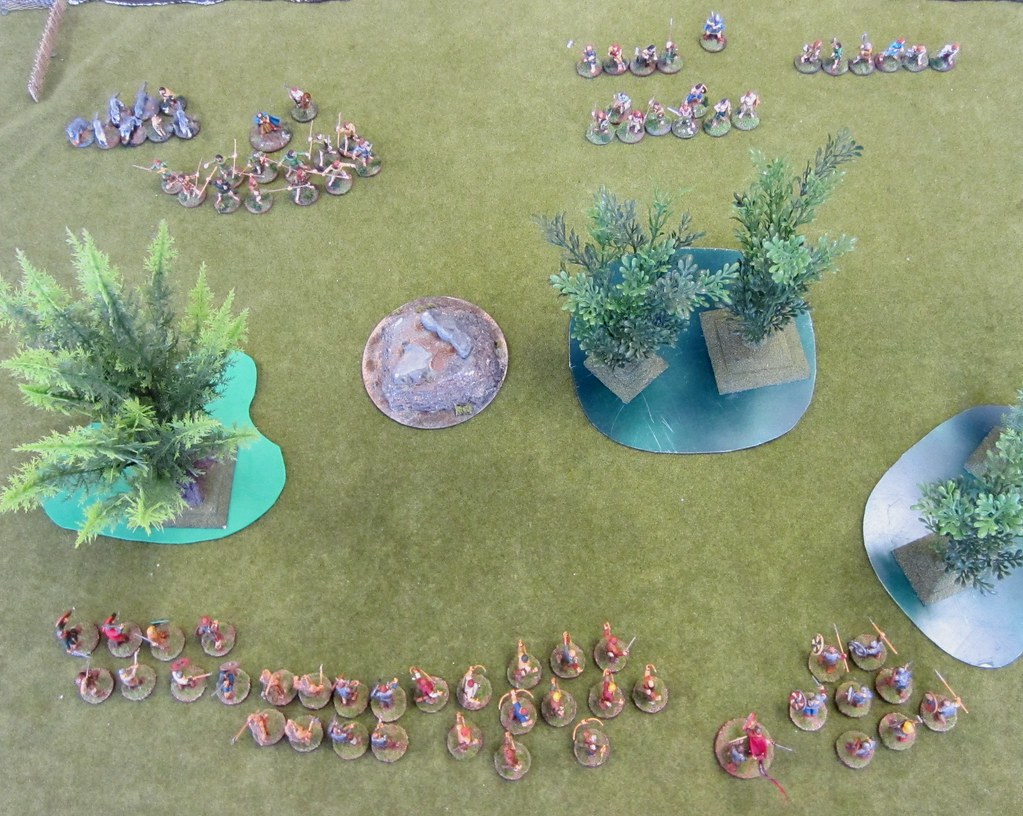 |
| Initial deployment, my Vikings are at the bottom of the photo. |
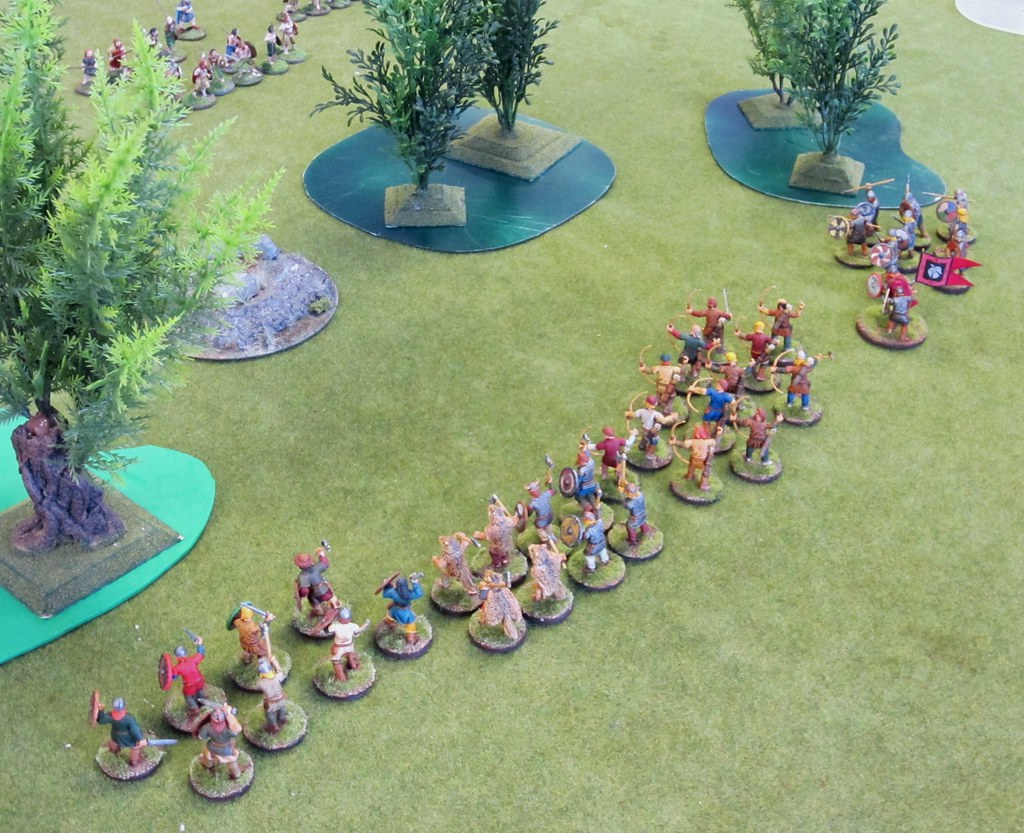 |
| My Vikings prepare to advance across the terrain. |
I gained initiative (I think I won on the "beard" tiebreaker - there's something to be said for having more hair below your eyebrows than above them!). My first turn was spent moving up, and trying to determine what Alan's strategy would be and how best to counter it.
 |
| Shades of things to come: the Irish levy taunt my Vikings! |
I did not have long to wait, as Alan advanced with his levy javelin throwers and started to try and whittle down my forces. Combined with the Sons of Dana battleboard ability which gives him a free shooting attack. this was quite annoying.
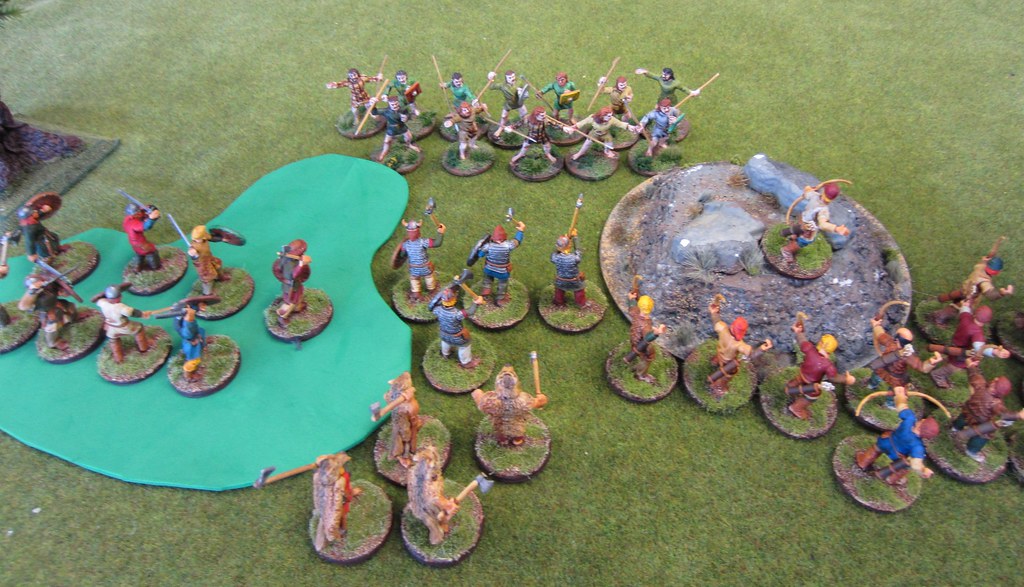 |
| Heirs of Mil allows the Irish to get right in front of the Vikings with impunity. |
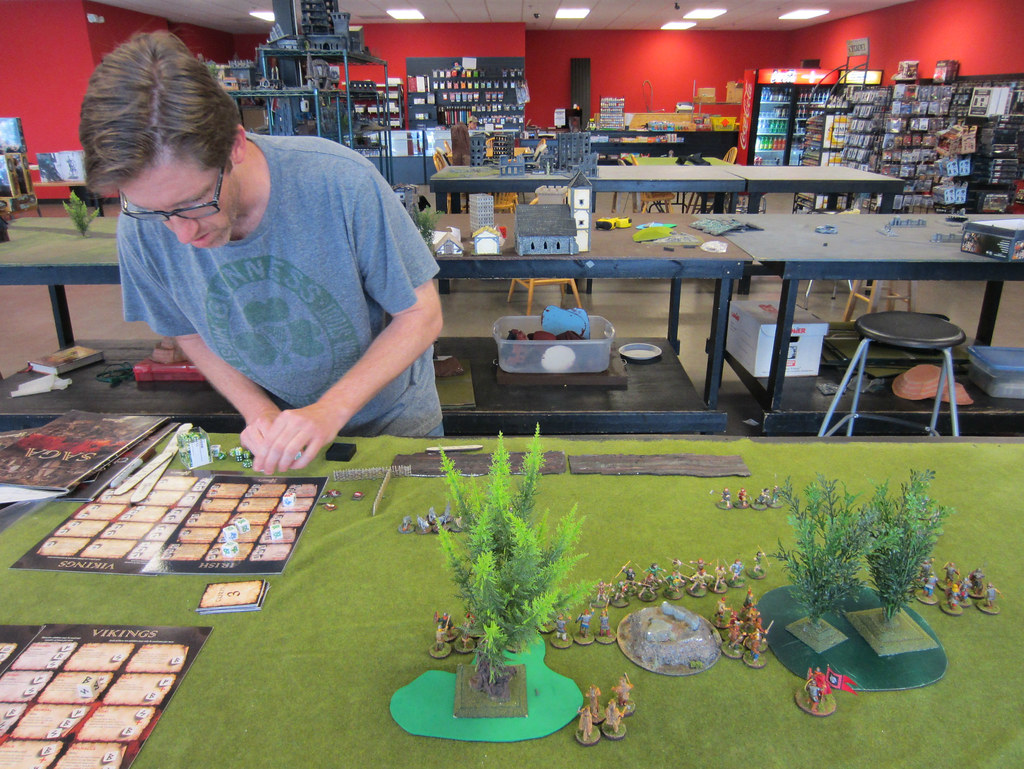 |
| Alan plans his turn. |
Over the course of the next several turns, Alan continued to gain victory points, while I fruitlessly chased his Irish levy. The Heirs of Mil ability is brutal! I couldn't charge or shot at his pesky javelin guys, and he kept placing them in very effective blocking positions to make it difficult for me to go around them and get to the rest of his forces.
 |
| Overview of the battlefield. The Irish levy on the left successfully screen Alan's Warlord from the bulk of my forces. |
Eventually, we did get to some melee combat, and it was a mixed bag for me. Alan ran his dogg unit around the left flank of my troops and came up from behind.
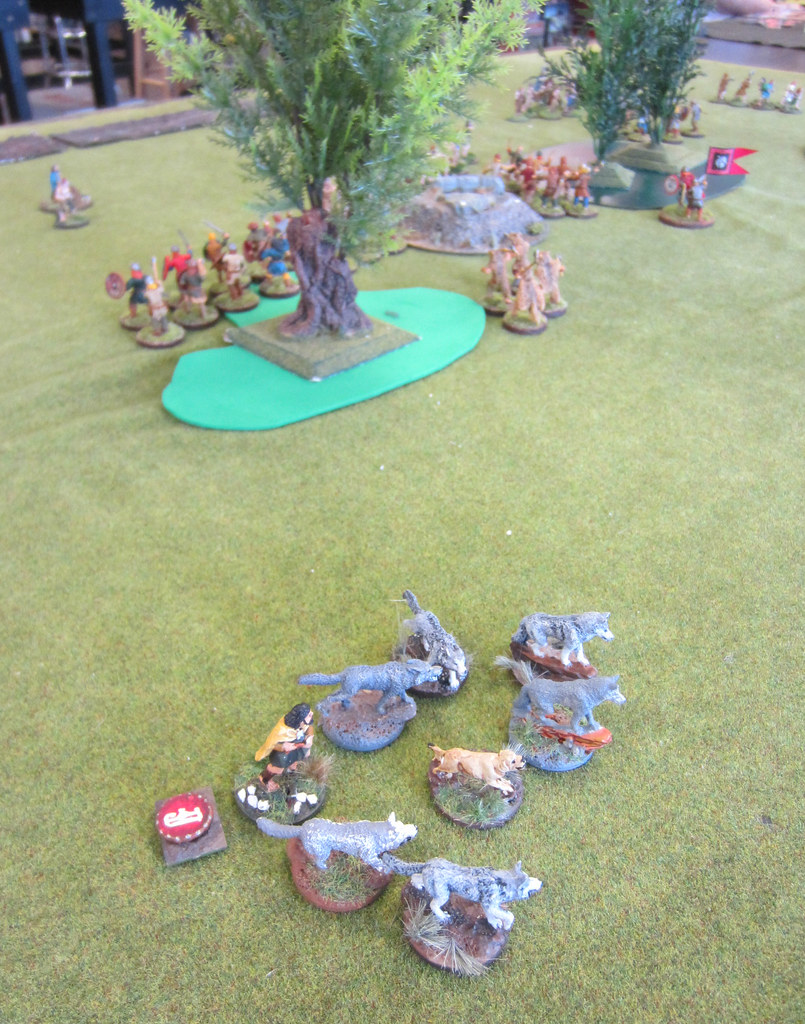 |
| The doggs make their move. |
I detached my Berserkers to cut him off. In a brutal combat, the Berserkers were killed to the man, while the handler and one dogg survived.
 |
| Fur flies in the melee! |
I misinterpreted a rule, and limited my attack dice, which could possibly have meant that the units mutually wiped each other out. But Alan outplayed me enough that it would not have made a difference in the end result - I might have lost by fewer points, but still lost. He really made the most of the terrain and his abilities to slow down and harass my Vikings.
My eight-strong hearthguard unit (down to five men due to those infernal javelins) ran into his hearthguard, and there was much bloodletting on both sides.
My Viking warriors finally managed to charge into his levy, and I was able to wipe them out in a couple of turns of melee. This was too little, too late, and a waste of my troops, since the levy are worth so few victory points. Seeing them finally off the table was very satisfying, but ultimately did not help me much in terms of scoring.
 |
| Satisfying, but ultimately futile (and feudal) combat. |
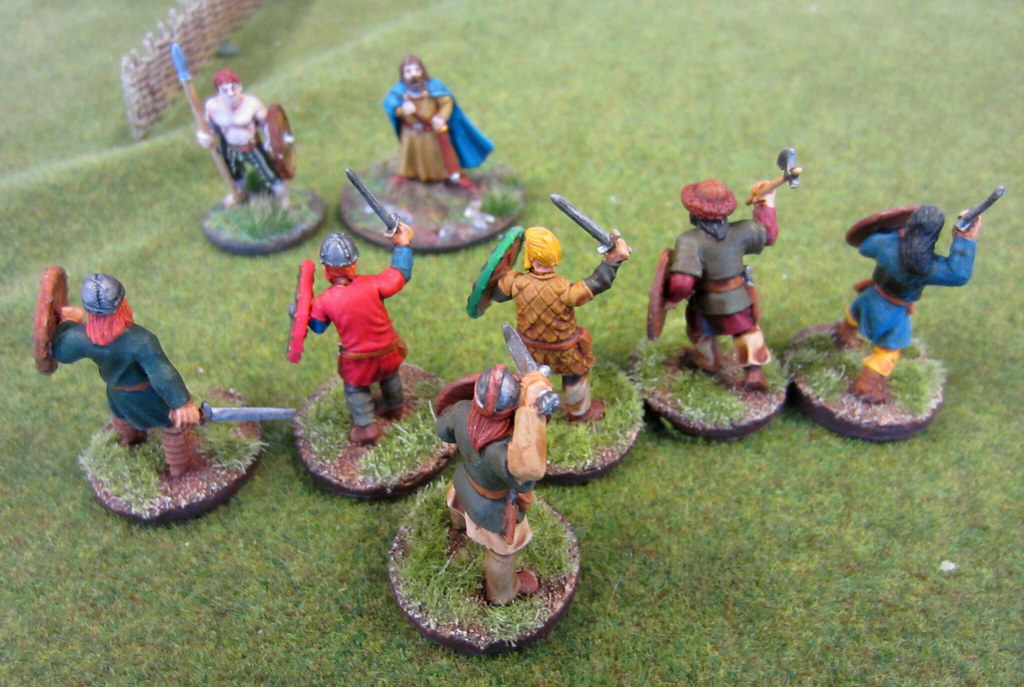 |
| Finally, a path to the enemy warlord! But the Curadh, using Heirs of Mil, was able to continue blocking me! |
Finally, in the end phase of the battle, I charged my warlord against the handler and surviving dogg, trying to score some last-minute points. Alan countered with The Old Ways. which limited my warlord to rolling two dice, the same as the dogg and handler! My dice abandoned me, and the warlord was slain.
Despite the loss, this was a very enjoyable game. Alan is a great opponent who is pleasant to play against even when he is pounding your army mercilessly. As usual, I learn more from a loss than from a win, and Alan taught me a lot in this game!
Lessons: Choose as little terrain as possible in games against the Irish! This limits their ability to use Sons of Dana.
And, as annoying as the Irish levy can be, scampering this way and that, peppering you with javelins and being immune to counterattack with the Heirs of Mil ability, they're still worth just 1 pt per three models - stay on target and focus on killing off the high-value units.
The Viking ability Odin doesn't do anything against javelins, since it turns a shooting activation into movement. Firing javelins happens as part of a movement activation, not a separate shooting activation, so they still get to throw their pointy sticks at you!
Result: A victory for the Irish, 20 vp to14 vp. Alan also got a bonus point for killing my warlord. After round one, I was 0-1 with zero points. The day could only get better!
And it did, as after this game we set up our armies to be judged for Best Painted. The overall quality of the painting was very good - everyone's army looked terrific, and the voting was very close. In the end, Sean's horde of Anglo-Saxons (with hand-painted shields) took the prize by a meager one vote! Congratulations Sean - well deserved recognition for the hard work you obviously put into your army.
After a break for lunch, it was time for:
Game 2 - The Escort
In this game, I faced Skip and his mounted Normans. Another first for me as I had not played against mounted troops before. And just as in my game against the Irish, the lessons learned were tough ones.
We bid for the honor of escorting the baggage train. I bid four points, and Skip bid five. I "won" the bid, and deployed my four points of Vikings to defend the baggage train. Skip picked five points of Normans, including two units of six mounted knights each, and set up his attacking forces.
Skip's Normans
Warlord (free)
Knights x6 (1.5 pts)
Knights x6 (1.5 pts)
Warriors with crossbows x8 (1pt)
Levy with bows x12 (1 pt)
Knights x6 (1.5 pts)
Knights x6 (1.5 pts)
Warriors with crossbows x8 (1pt)
Levy with bows x12 (1 pt)
Henry's Vikings
Warlord (free)
Berserkers x4 (1 pt)
Hearthguard x8 (2 pts)
Warriors x8 (1 pt)
 |
| I'm not protecting a well and graveyard - those are the baggage pieces! |
We didn't have pieces that actually looked like baggage, which is why you'll see my Vikings guarding what appear to be small terrain pieces. Don't let the appearance fool you - they're actually the Vikings' very valuable baggage train. My mission was to get as many of those pieces safely across the board as possible, while Skip would do everything in his power to stop me!
In addition to the usual points for winning the scenario, bonus points were available for killing the enemy warlord, getting all three baggage pieces to safety, or winning while losing 10 victory points or less of troops (if you were the attacker).
The first turn was rather uneventful, as I moved up as much of my force as possible, making sure to keep my troops between the baggage and the enemy.
Here is where I made another costly blunder - my Berserkers were deployed in line with the rest of my army, rather than being screened behind the other warriors. You guessed it! Skip saw this weakness and exploited it immediately, pelting my Berserkers with arrows on his first turn and eliminating them. He was kind enough not to laugh out loud as he made me pay for my poor deployment!
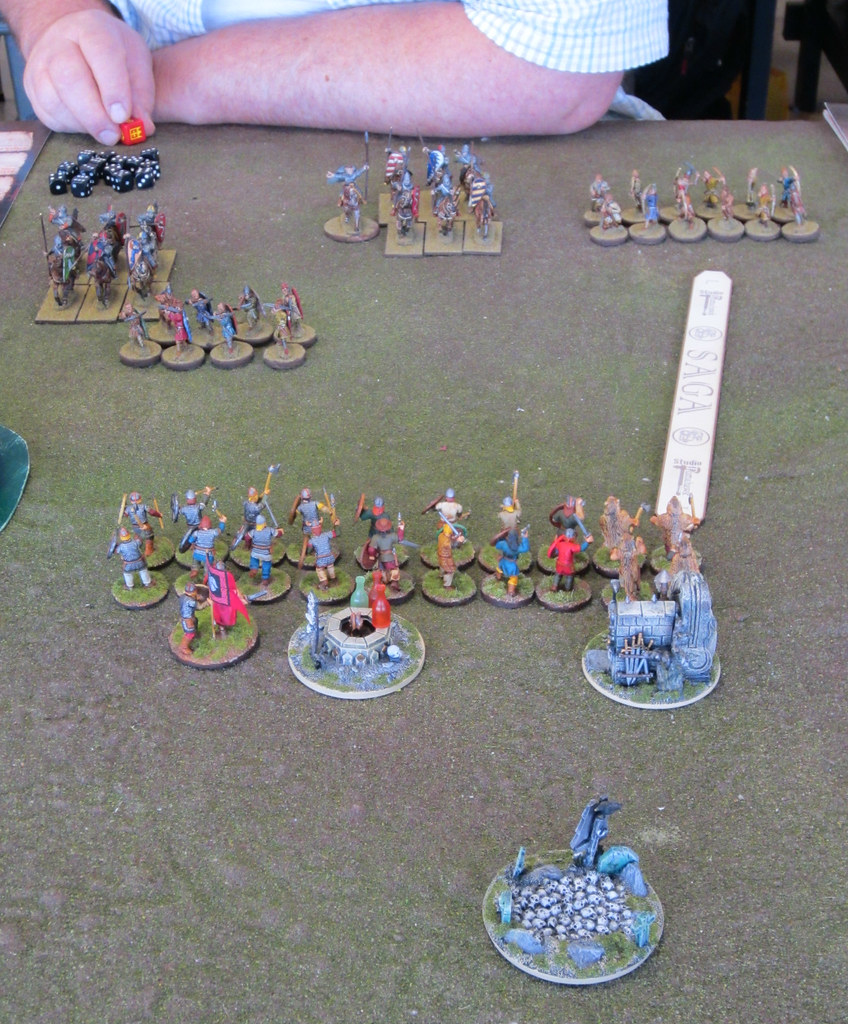 |
| Skip measures before advancing to within bowshot range and wiping out my Berserkers. |
Skip also began to move one of his knight units around my left flank, in preparation for assaulting my baggage train from the rear.
On the second turn, I continued my advance, activating as many units as possible for movement. My Bondi were able to attack Skip's bowmen on the right, and drive them off with heavy losses.
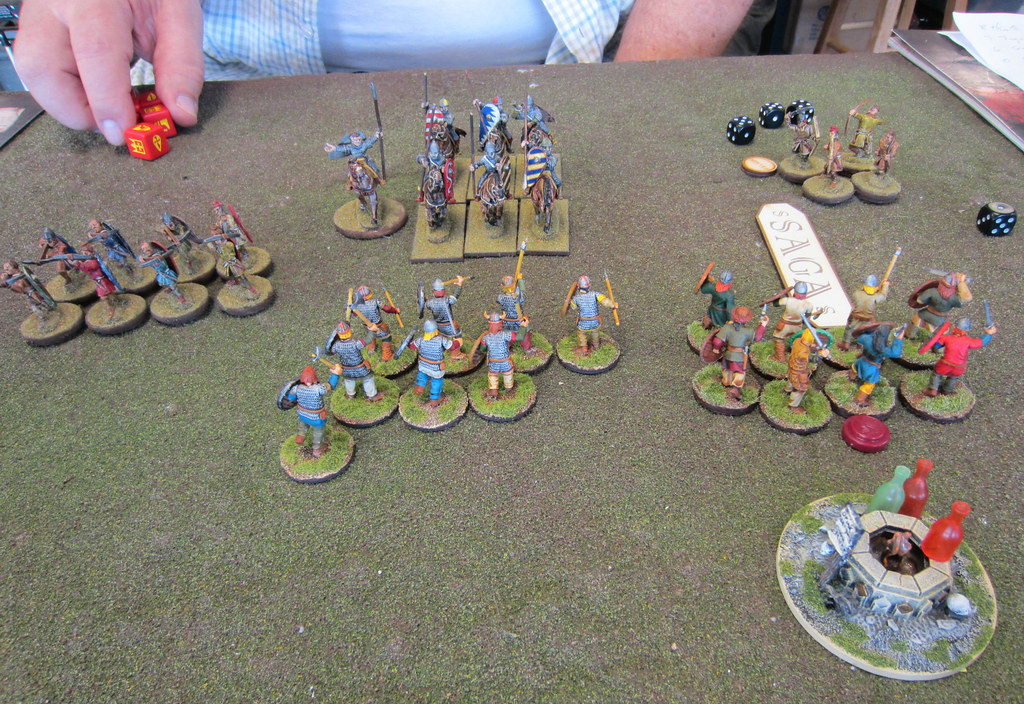 |
| My Hirdmen and Bondi screen the baggage from the enemy. |
You'll notice in the picture that Skip's knights, which were behind his crossbowmen, are now gone... because they swept around behind my troops!
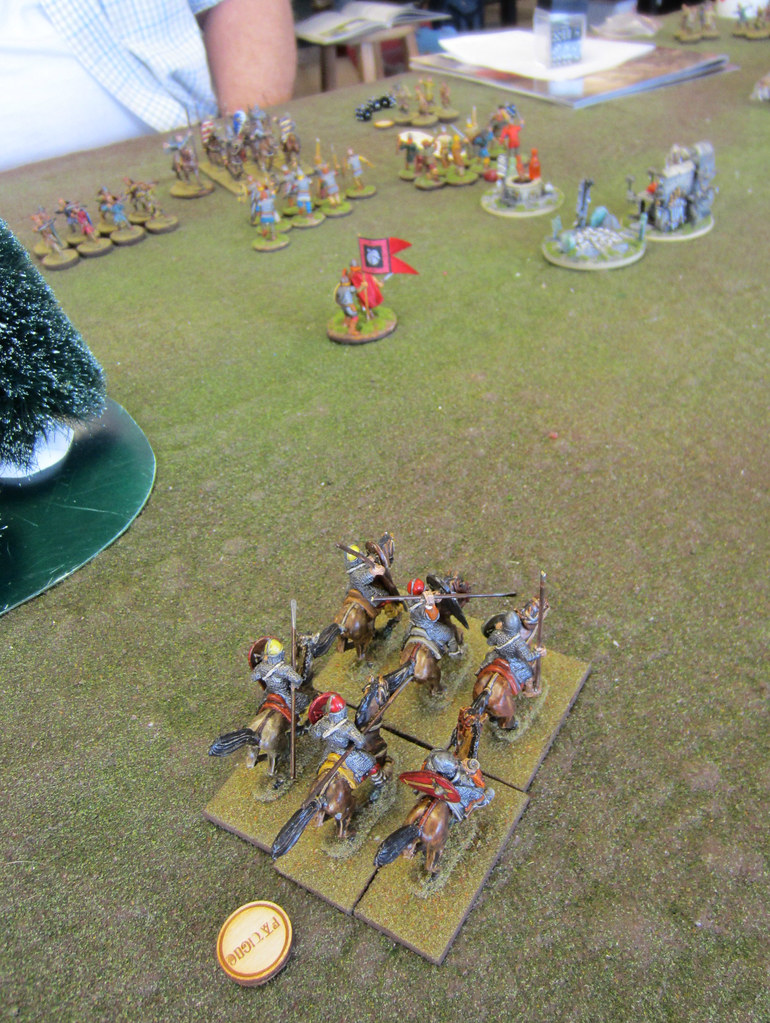 |
| Norman knights in the rear. |
On his turn, Skip attempted to charge - but I used his fatigue to slow him down, stopping him before he could make contact.
Meanwhile, I charged my Hirdmen into his warlord and knightly retinue. Lots of dice were rolled - I think each of us rolled 16 hits! Both units were wiped out - leaving the warlord standing tall in the saddle, with his "I'm king of the world!" pose.
Our warlords faced each other across the field of battle, no longer protected by intervening troops.
Faced with the choice of running up to engage the opposing warlord, or hanging back to protect the baggage from the marauding knights, I chose to have my warlord screen the baggage.
Meanwhile, you can see in the top right corner that my Bondi have cleared a path for the baggage to reach the corner of the board and escape.
The final turns saw my warlord valiantly defeated by Skip's knights, who then managed to capture the baggage. His warlord was able to charge and kill a second baggage train piece, but I managed to barely get one off the board to pull out a draw in this scenario. Phew!
Another fun game against a great opponent. Skip was a gentleman in every aspect of the game and once again, I was taught a lot about proper planning and troop placement.
Lessons: Keep your friends close, and your Berserkers closer! Do NOT just leave them sitting on the end of your battle line with a big neon "Shoot at me!" sign on them.
The Viking ability Odin, which denies an enemy their shooting attack, is very useful against the Normans. Although Skip was able to get off shots with his bowmen, I managed to counter a lot of incoming shots from the crossbowmen.
Result: A draw, with Skip scoring a bonus point for killing my warlord. I was sitting at 0-1-1 halfway through the tournament, with just one point.
Game 3 - Sacred Ground
This was an epic clash between rival bands of marauding Vikings! My warband against Wes and his 1/72 scale Zvezda Vikings. I have to say, despite their slightly smaller size, I was very impressed with the look of the Zvezda figures. And Wes' paint job made them look even better. (You can see them at the Plastic Soldier Review site.)
In this match, bonus points would be awarded for killing the enemy warlord, as well as for scoring twice as many victory points as the opponent. Points were scored for having models on the sacred terrain at the end of each of your opponent's turns. The number of points you could score was limited to a maximum of eight points per terrain piece per turn. This forced you to spread out your forces to maximize your points, rather than concentrate your entire warband on one terrain piece.
Wes' Vikings
Harald Hardrada (1)
Hearthguard (Varangians) x4 (1 pt)
Warriors x8 (1pt)
Warriors x8 (1pt)
Warriors x8 (1pt)
Levy archers x12 (1 pt)
Hearthguard (Varangians) x4 (1 pt)
Warriors x8 (1pt)
Warriors x8 (1pt)
Warriors x8 (1pt)
Levy archers x12 (1 pt)
Henry's Vikings
Warlord (free)
Berserkers x4 (1 pt)
Hearthguard x4 (1 pt)
Hearthguard x8 (2 pts)
Warriors x8 (1 pt)
Levy archers x12 (1 pt)
We placed the terrain and rolled for initiative - once again my beard won me the honor of deploying first. Since we both had the same number of units, I finished deploying first as well, which meant that I got to move first (which is an advantage in this particular scenario).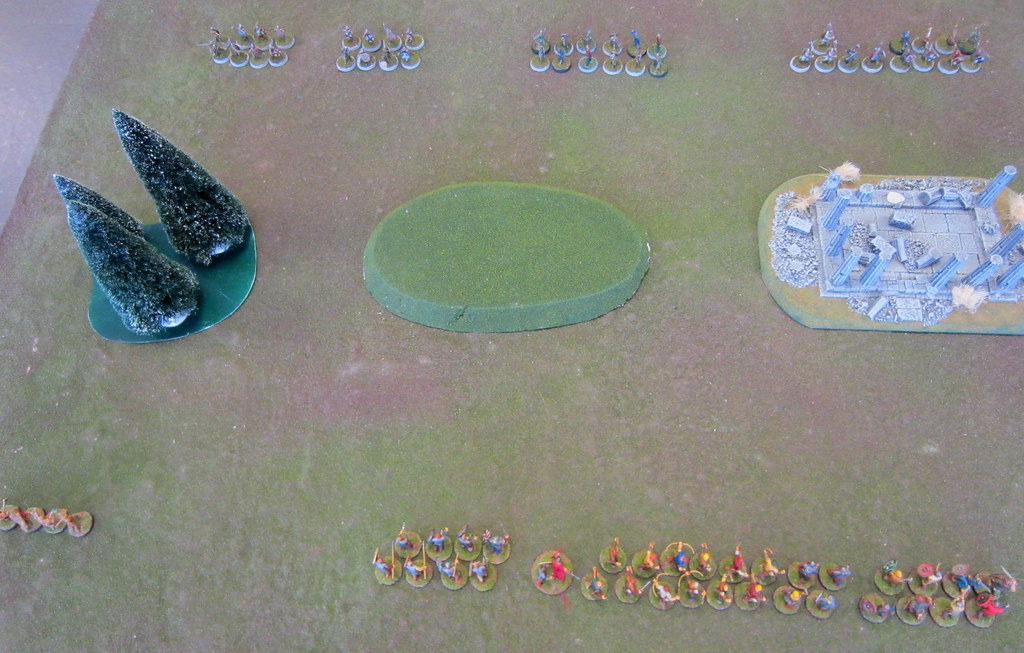 |
| Initial deployment. |
On my first turn I was able to advance a couple of my warriors on the central sacred hill, and place my other troops in good position to move onto the forest on the left and the ruins on the right in the coming turn. Wes moved his Vikings into position, threatening to rush the sacred areas in turn two.
On turn two I managed to get the rest of my Hirdmen onto the central hill, and consolidate on the right before advancing into the ruins in force.
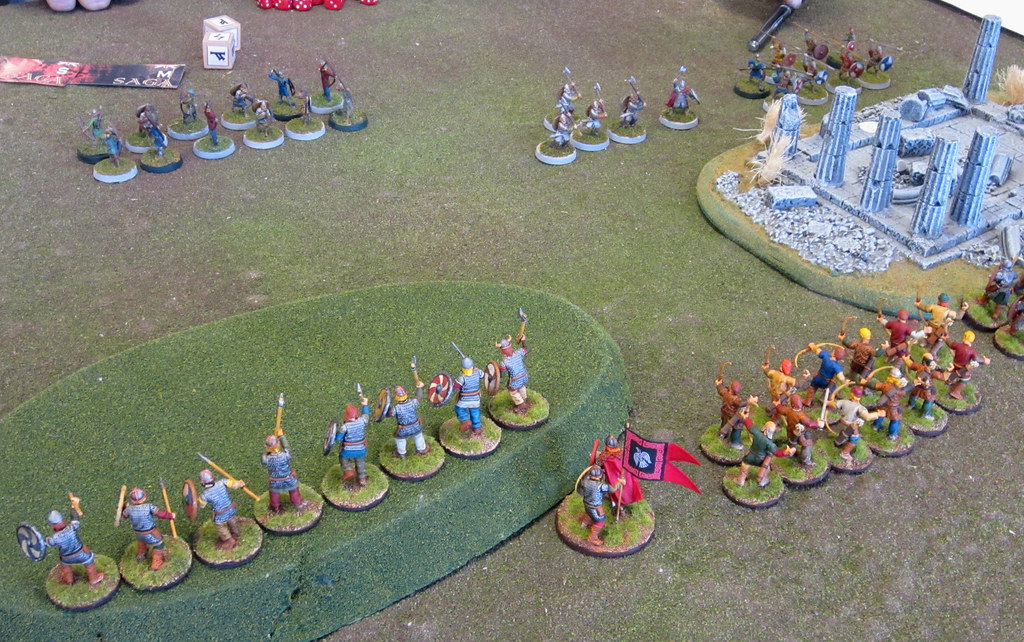 |
| Warriors charge onto the sacred hill! |
On the next turn, I moved the hearthguard and warriors on the right into the ruins, poised to score some big points.
While I controlled the center and right, on my left things were a little more combative. My Berserkers were engaged by a unit of eight enemy warriors. In keeping with the day's theme, although they managed to kill off all the enemy, my Berserkers were all cut down. This cleared the way for Wes to move his second unit of warriors into the forest uncontested, and begin scoring points for that terrain feature.
In the closing turns, Wes charged his Varangians into the gap between the two terrain pieces on my right, trying to destroy my archers (which had been pestering him with arrows much of the game). While he was able to kill off most of them, his unit also suffered casualties. And in an ensuing melee between his warlord and my Hirdmen, his warlord fell! I was left firmly in control of the central and right terrain, while he controlled the left.
In this game, everything went well for me, my strategy paid off and my dice were hot. Unfortunately for Wes, his dice went ice cold and he was unable to budge my troops from the sacred terrain. Despite being on the losing end, Wes was a very gracious and honorable opponent.
Lesson: Yet again, I did not use my Berserkers well. Though they did kill off a unit of his warriors, they were in turn killed rather easily. I will need much more practice with the Ulfhednar to learn how to utilize them to their best effect.
Result: I won the game, 79 to 25, and earned two bonus points. Going into the final match, I was 1-1-1 and had six points. I was back in the hunt!
Game 4 - Homeland
After playing three games against players I had never faced before, in the final game I was across from a very familiar face - Brian. He's one of my all-time favorite people to game against, and I knew this was going to be a great game.
Once again, there was a bidding process to determine the defender and the attacker. I bid four points, while Brian bid five, so it fell to me to defend my village against a savage Anglo-dane attack!
Despite losing the bid with five points, Brian was given six points of troops to use in the attack. Meanwhile, we ruled that the larger central house could hold up to 12 models, while the smaller houses on the ends could fit eight each. Horses can not enter the buildings, but since I was facing Anglo-danes, this was a moot point.
Brian's Anglo-danes
Warlord (free)
Hearthguard x8 (2 pts)
Warriors x8 (1pt)
Warriors x8 (1pt)
Warriors x8 (1pt)
Levy with bows x12 (1 pt)
Hearthguard x8 (2 pts)
Warriors x8 (1pt)
Warriors x8 (1pt)
Warriors x8 (1pt)
Levy with bows x12 (1 pt)
Henry's Vikings
Warlord (free)
Berserkers x4 (1 pt)
Hearthguard x8 (2 pts)
Warriors x8 (1 pt)
The bonus points for this match would be awarded for killing the enemy warlord, controlling all three buildings at the end of the game (defender), or for winning without losing more than 12 victory points of troops (attacker).
I am quite fond of my Berserkers, because I love the look of the models, so I chose them as one of my four points. I should have left them at home, because they were fairly useless in this scenario, at least the way I used them. I place them in the central building, accompanying my warlord.
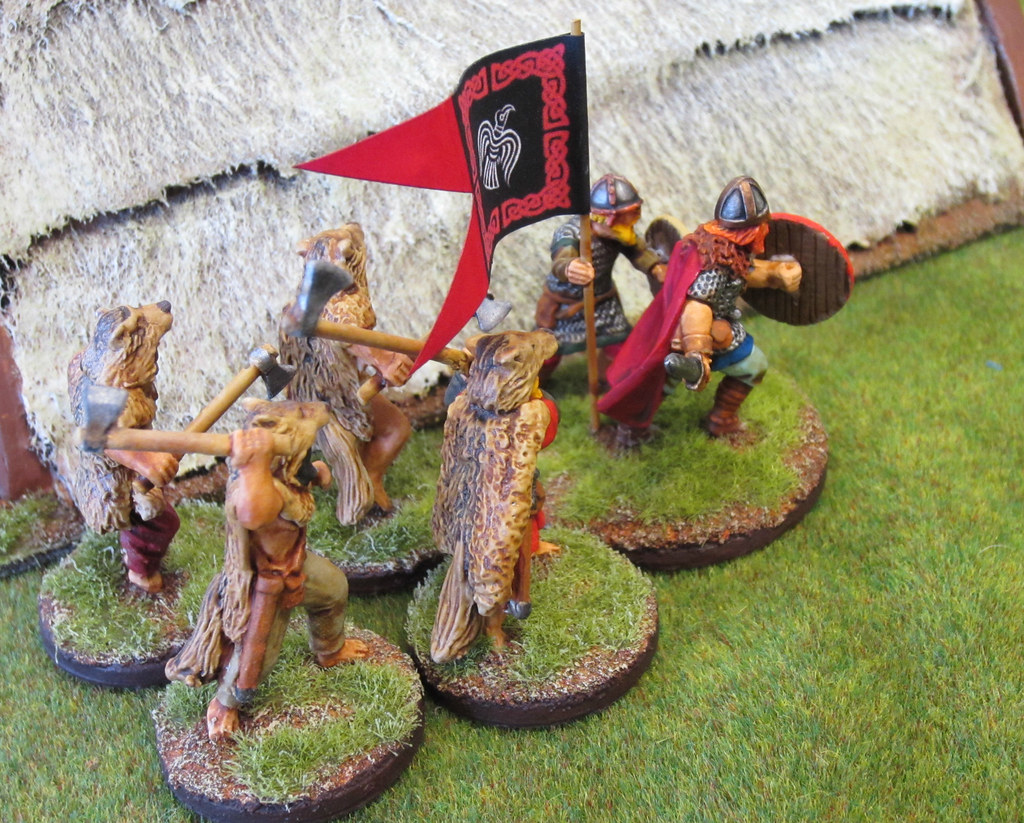 |
| My warlord and Berserkers. Since the roof is not removable, I placed them beside the building. |
On the right I placed a point of warriors, while on the left I placed a unit of eight hearthguard.
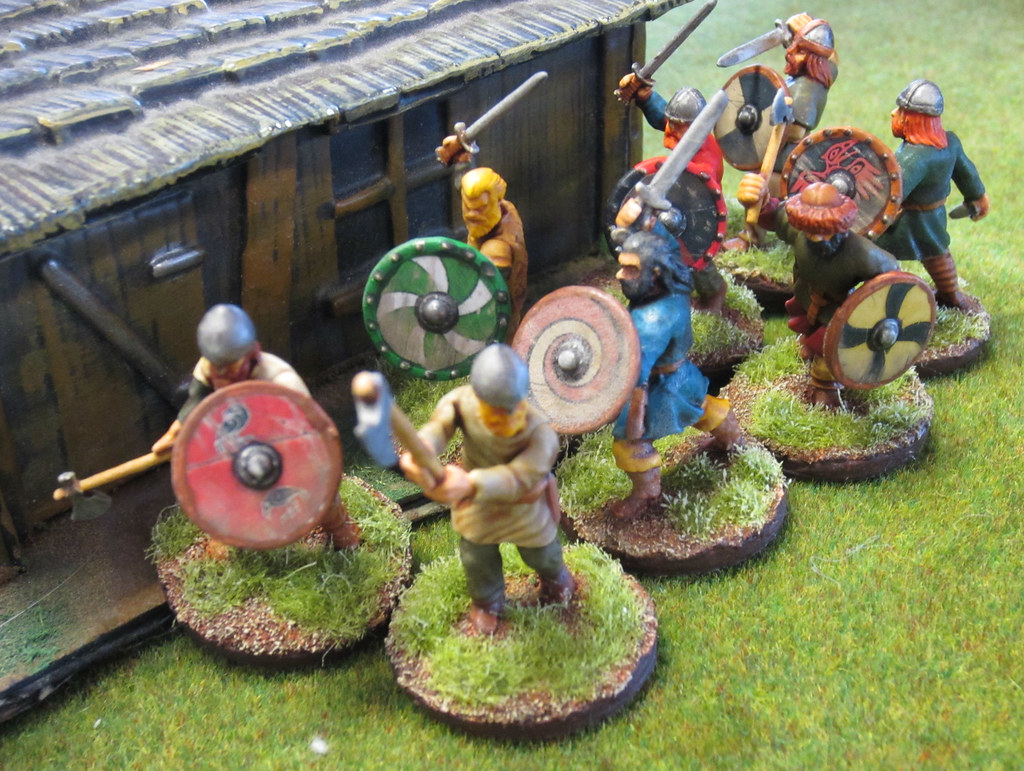 |
| No, really, we're inside the house! |
Brian deployed his Anglo-danes in a line stretching across the field of battle.
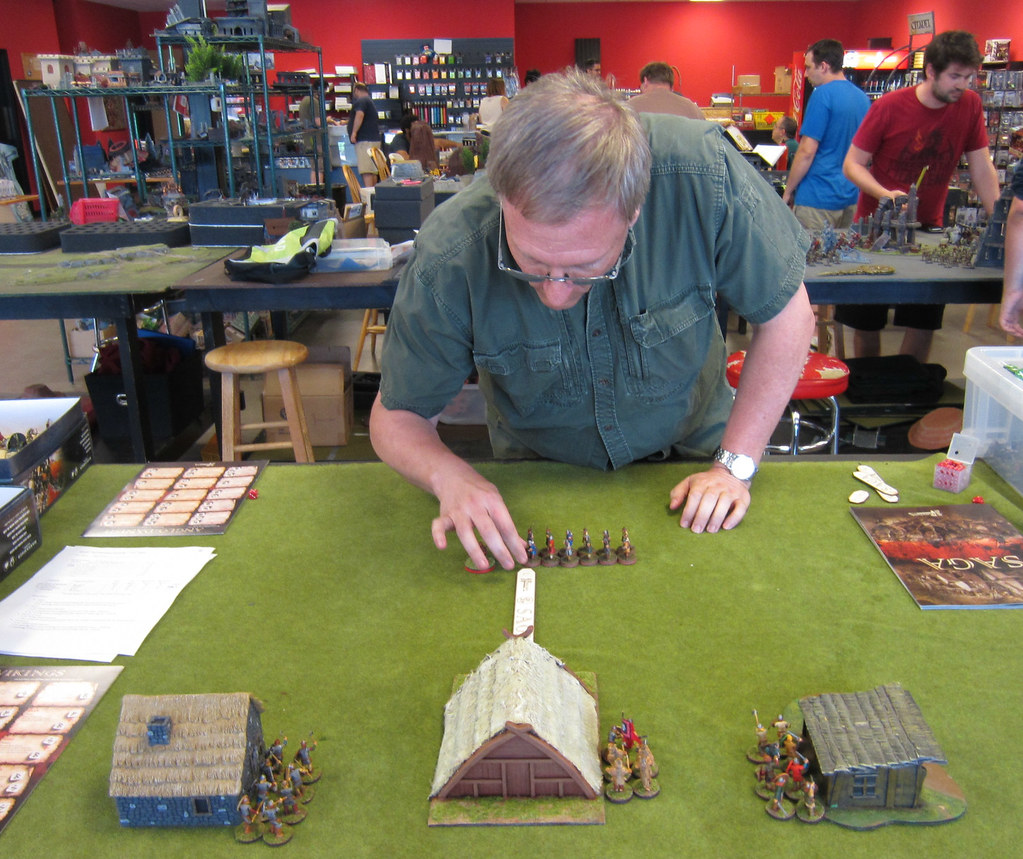 |
| Brian carefully measure his deployment. |
 |
| There sure are a lot of Anglo-danes approaching. Hope they're friendly! |
 |
| The impressive Anglo-dane shield wall! |
On the first turn, Brian used Trapped to give fatigue to three of my units, then unleashed a barrage of arrows at the Berserkers in the central house.
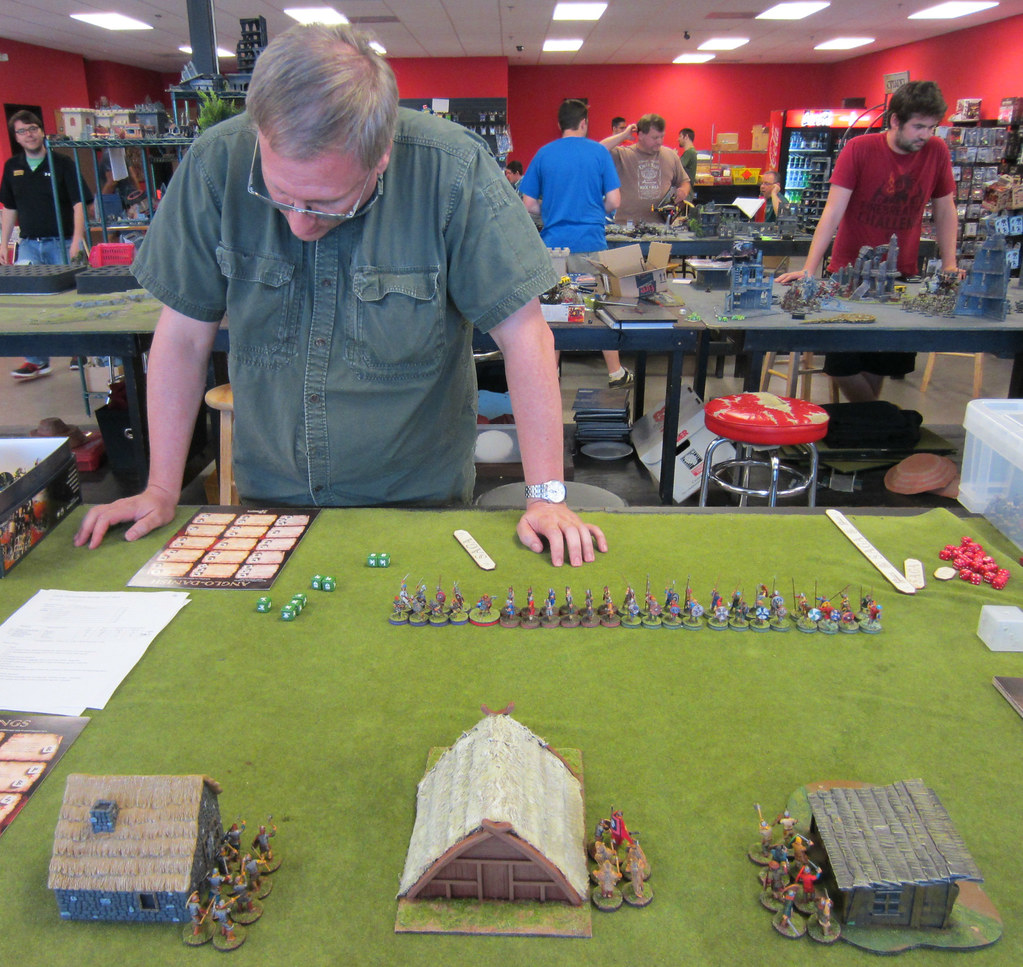 |
| Brian ponders what Anglo-dane deviousness he can throw at my Vikings. |
 |
| One Berserker failed his save, and died in a hail of arrows. |
On turn two, Brian continued his advance, and this time his arrows were more effective, killing off the last of the Berserkers. Despite the hard cover from being inside the house, Berserkers are still very vulnerable to missile fire. I'd have done better to take a unit of regular hearthguard in their place - lesson learned.
Once the Berserkers were cleared out, Brian charged his own hearthguard into the large building and engaged my warlord. I killed some of the Huscarls, but my warlord was killed as well. He only managed to survive one of the four battles during the tournament - he must have a death wish!
Meanwhile, on my right, Brian sent three units of Ceorls to engage my Bondi.
Over the course of the next four turns, he charged his forces in, time and time again, whittling down my defending warriors and giving them fatigue. The special rules for a building mean that unless the attacker completely wipes out the defending unit, they have to retreat after the melee regardless of who suffers the most casualties. This meant that my Bondi were able to hang tough after each combat.
On the left, Brian did eventually charge his Huscarls into combat with my Hirdmen, but I was fortunate to roll well and win the melee decisively, only losing one model.
On the right, the numbers in Brian's favor made themselves felt, and the brave Bondi finally succumbed. Now Brian was in possession of two of the three village buildings.
Unfortunately for him, he did not have enough units left on the other flank to threaten my hearthguard in the time remaining, and he pulled his warlord back rather than leave him in a position where he'd be vulnerable to a sortie from me.
Having the hearthguard in control of that one building gave me the win!
Lesson: Homeland is incredibly tough for the attacker, and frankly a bit boring for the defender. I did not have enough points to do much else than just sit in the buildings and try to weather the onslaught. There's not much strategy to just rolling dice when you get attacked. All my important decisions, both good and bad, were made when I deployed.
Result: Another win for the Vikings! Three points for me, and Brian earned a bonus point for killing my warlord. With this result, I finished 2-1-1, with a total of nine points.
Overall result: I finished in second place. I tied with Brian in points with nine, but edged him out in victory points (I told you they'd be important) by killing more enemies during the course of the day. No one was really close to Alan, who finished undefeated (three wins and a draw), with 11 points.
Overall lessons:
- The Irish are tough!
- Be as familiar as possible with the rules. I am aware of at least one occasion where I misinterpreted a rule and shortchanged myself on the number of attack dice I rolled. I am certain I also made mistakes in my favor.
- Berserkers are great in hand-to-hand, but they need to be protected in order to get into melee with the enemy. Otherwise, they quickly become nothing more than wolf-shaped pincushions!
- Protect your warlord! This goes without saying, but what I mean by it is don't be afraid to go defensive in combat - giving up some offense to give your warlord a better chance of surviving can be a huge factor in the game.
- Concentrate on the scenario objectives, and stay focused on your overall plan. Obviously, there's a fine balance between not getting distracted from your main strategy, while remaining flexible enough to react to your opponent's moves.
- Have I mentioned how tough the Irish are? I now have three warbands (Welsh, Irish and Pagan Rus) on my painting table waiaintg for me to finish off my final points of Vikings. After Saturday's tournament, the Irish have jumped to the top of that list!
And, once more, a huge thank you to Gripping Beast. Not just for their support of our tournament, but for creating this wonderful game! It truly is one of those games that is simple enough to learn quickly, yet has a depth and complexity that make you keep wanting to play it in an attempt to master it.
I am eagerly looking forward to the next tournament - I just hope I have time to paint up my Irish before-hand!
'Til next time!
P.S. - While I was at Giga-Bites on Saturday, I picked up a copy of Saga: The Crescent and the Cross. I wanted it for the updated rules that apply to Saga, as well as to start researching a Spanish warband. Stay tuned for a review...
Subscribe to:
Comments (Atom)


